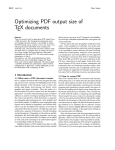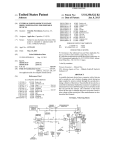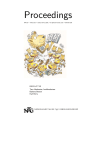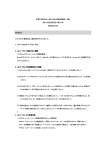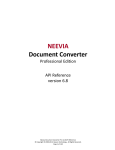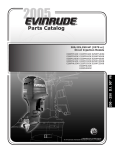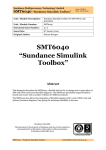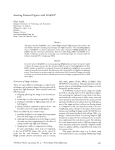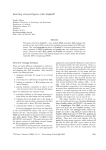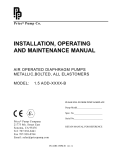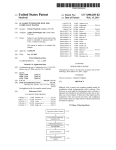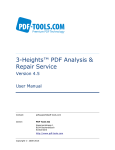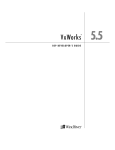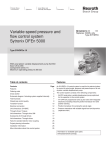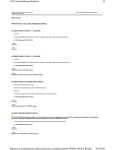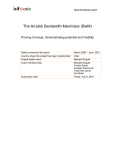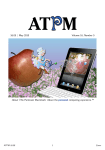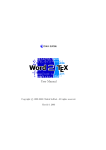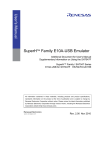Download Efficient portable document
Transcript
USOO8433997B1
(12) United States Patent
(10) Patent N0.:
(45) Date of Patent:
Szabo
(54)
Bienz et al. (“Portable Document Format Reference Manual”Versi0n
Peter Szabo, Zurich (CH)
(73) Assignee: Google Inc., Mountain View, CA (U S)
(*)
Notice:
Subject to any disclaimer, the term of this
patent is extended or adjusted under 35
U.S.C. 154(b) by 0 days.
This patent is subject to a terminal dis
claimer.
Aug. 2, 2010
(60)
Provisional application No. 61/230,681, ?led on Jul.
31, 2009.
(51)
(52)
Int. Cl.
G06F 17/00
US. Cl.
(58)
USPC .......... .. 715/209; 715/205; 715/235; 707/693
Field of Classi?cation Search ................. .. 715/209
available at http://www.ad0be.com/devnet/font/pdfs/S176.CFF.pdf,
62 pages.
enhancer edition?” 2009, 4 pages.
Cho et al. “The DVIPDFMX Project,” 2011, available at http://tug.
org/teXlive/devsrc/Build/source/teXk/deipdfnvi/, 10 pages.
(Continued)
(74) Attorney, Agent, or Firm * Fish & Richardson PC.
documents involves obtaining, at a computer system, an elec
U.S. PATENT DOCUMENTS
1/2009
Primary Examiner * Cesar Paula
Assistant Examiner * Quoc A Tran
(57)
ABSTRACT
A computer-implemented method for formatting electronic
References Cited
7,478,324 B1 *
Adobe, “The Compact Font Format Speci?cation,” 1.0 edition, 2003,
(2006.01)
See application ?le for complete search history.
2006/0187478 A1*
2007/0271288 A1*
ACM, 10 pages).*
Adobe, “Adobe Acrobat Pro 9,” 2009, 1 page.
Adobe, “PDF Reference Sixth Edition-Portable Document Format,”
version 1.7, 2006, available at http://www.ad0be.com/devnet/pdf/
pdfireferenceiarchivehtml, 1310 pages.
pages.
Apago, Inc. “PDF EnhmceriWhich features are in what PDF
Related US. Application Data
(56)
1.2 dated Nov. 2, 1996 by Adobe System Incorporated, 394 pages).*
Phelps et al. (“Two diet plan for fat PDF” dated Nov. 20-22, 2003 by
“Adobe Acrobat 8.0 Professional4Optimizing PDF Files,” 2009,
Website Optimization, LLC., 15 pages.
Apago, Inc. “PDF EnhanceriAutomate the Assembly, Preparation
and Optimization of PDF for Print, Web and Archiving,” 2005, 2
(21) Appl. No.: 12/848,787
(22) Filed:
*Apr. 30, 2013
Reidar (“A DVI preview in Java” published Nov. 1, 2006 by “Uni
versity of Oslo” 112 pages).*
EFFICIENT PORTABLE DOCUMENT
(75) Inventor:
US 8,433,997 B1
Ohtsu ......................... .. 715/255
8/2006 Kongtcheu et a1. ........ .. 358/113
11/2007 Martin et al. ............... .. 707/101
OTHER PUBLICATIONS
tronic document in a source format. The process also involves
processing the electronic document by optimizing sizes of
one or more images embedded in the electronic document,
optimizing sizes of one or more Type 1 fonts in the electronic
document, and removing object duplicates in the electronic
Fazekas (“pdfsizeopt.py” published Mar. 29, 2009 by “pts@fazekas.
document. In addition, the process involves generating the
hu”, as an open source on the WWW pp. 1-87.*
document in a target format based on the processing.
Peter Zabo “Conversion of TeX font into Type 1 format” Published
2001 pp. 1-18.*
23 Claims, 3 Drawing Sheets
Receive User Identification of Document
Obtain Electronic Document In Source Format
2%
Process Document
- Optimize Embedded Image Sizes
- Optimize Font Sizes
- Remove Object Duplicates
- Set Zip Compression Level
- Generate Streams
- Encode Fonts To CFF
- Create Graphics Based On Font Sub Setting
- Disable Sub Setting
- Embed Graphics File Once
M
Cycle Through Processing With Publicly
Available Applications
222
Generate Output Document In Target Format
And Provide To User
US 8,433,997 B1
Page 2
OTHER PUBLICATIONS
CodeMantraiDigital Publishing Made Manageable. “Universal
PDF,” 2002-2012, 2 pages.
“Compressing your PDF ?les,” very.PDF.com, Inc., 2006, available
at http://www.verypdf.com/pd?nfoeditor/pdfcompress.htrn, 6 pages.
“DjVu: A Tutorial,” available at http://www.djvuzone.org/support/
tutorial/chapter-intro.html, 1998-2000, 3 pages.
Fowler. “Linux/BSD/Mac OS X ports of Ken Silverman’s Utilities,”
2007, available at http://www.jonof.id.au/kenutils, 3 pages.
Gimp.org. “Gimp2.6iRelease Notes,” 2001-2011, available at
http://www.gimp.org/, 14 pages.
“JBIG2,” 2012, GitHub Inc., available at www.jpeg.org/public/
fcd14492.pdf, 2 pages.
Koenig, “Creative use of PDF ?les in latex environments: What
Adobe won’t tell you . . . ,” Chemnitz University of Technology,
Department of Computer Science, 2004, pp. 1-30.
Lizardtech. “DjVu,” djvu v3 edition, 2005, available at http://djvu.
org/docs/JtVu3 Spec.djvu, 70 pages.
PackJPG. “Latest Binary Releases of PackJPG: V2.3,” 2007, 1 page.
“PDF Compress Command Line User Manual,” very.PDF.com, Inc.,
2006,
available
at
http://www.verypdf.com/pd?nfoeditor/
pdfcompress.htm, 4 pages.
“PDF CreatoriThe free PDF Creator and Converter,” available at
pdfforge.org, 2012, 1 page.
Phelps and Watry. “A No-Compromises Architecture for Digital
Document Preservation,” Proceedings of the 9th European Confer
ence on Research and Advanced Technology for Digital Libraries
(ECDL 2005), 2005, 12 pages.
Phelps and Wilensky. “Two Diet Plans for Pat PDF.” DocEng 03’,
2003, ACM, 10 pages.
Phelps. Sourceforgenet. “Multivalent,” 2011, available at http://
multivalent.sourceforge.net/index.html, 1 page.
Phelps. Compact PDF Speci?cation, 2004, available at http://
multivalent.sourceforge.net/Research/CompactPDthml, 3 pages.
Phelps. “Compressithe multivalent pdf compression tool,” 2009,
available at http://multivalent.sourceforge.net/Tools/pdf/Compress.
html, 4 pages.
Phelps. “Multivalent download location,” 2009, available at http://
sourceforge.net/projects/multivalent/?les/, 1 page.
“PSTricks websiteiPDF export,” 2012, available at http://tug.org/
PSTricks/main.cgi??le:pdf/pdfoutput, 11 pages.
Rahtz. “The pdiTeX user manual,” 2007, available at http://sarovar.
org/proj ects/pdftex/, 45 pages.
Rokicki. “Dvips: A DVI-to-PostScript Translatorimanual for ver
sion 5.96,” 2007, 65 pages.
Silverman. “Ken Silverman’s Utility Page4Compression Utilities,”
1993, available at http://www.advsys.net/ken/utilshtm, 11 pages.
Skala, “How to concatenate PDFs without pain,” 2008, available at
http://ansuz.sooke.bc.ca/software/pdf-apendphp, 4 pages.
Still. Stillhq.com. “PDF Database,” 2005, available at mikal@stillhq.
com, 17 pages.
Szabo. “Sam2p,” available at http://pts.szit.bme.hu/sam2p/, 4 pages.
Szabo. “Example PDF ?les the PDF size optimizers were tested
with,” 2009, 1 page.
Szabo. “Extra ?lesipdfsizeopt and PDF ?le size optimizer,” 2011,
available
at
http://code.google.com/p/pdfsizeopt/source/
browse/#svn/trunldextra, 1 page.
Szabo. “Inserting ?gures into TeX documents,” Proceedings of the
2001 Annual Meeting, TUGboat, 2001, in EuroBachoTeX 2002, pp.
100 1- 1007.
Szabo. “Installation instructions,” 2011, available at http://code.
google.com/p/pdfsizeopt/wiki/InstallationInstructions, 2 pages.
Szabo. “pdfsizeopt,” 2011, 1 page.
Tantau. “The Tikz and PGF PackagesiManual for Version 2.10,”
2008, available at http://sourceforge.net/projects/pgf, 726 pages.
Tantau. “User Guide to the Beamer ClassiManual for version 3 .07,”
2007, available at http://latex-beamer.sourceforge.net, 224 pages.
Truta. Sourceforgenet. “A guide to PNG optimization,” 2008, avail
able at http://optipng.sourceforge.net/pngtech/optipnghtml, 9 pages.
Truta. Sourceforgenet. “OptiPNG: Advanced PNG Optimizer,”
2009, available at http://optipng.sourceforge.net/, 3 pages.
Virtanen. “textextiInkscape,” 2009, available at http://www.
elisanet.?/ptvirtan/software/textext/, 2 pages.
White. “PostScript-to-PDF converter,” 2008, available at http://
ghostscript.com/doc/current/Ps2pdf.htm, 16 pages.
Wikipediaorg. “OptiPNG,” 2006, available at http://en.wikipedia.
org/wiki/OptiPNG, 2 pages.
Oksnevad, Reidar; A DVI Previewer in Java, published Nov. 1, 2006,
University of Oslo, 112 pages.
* cited by examiner
US. Patent
Apr. 30, 2013
Sheet 1 0f3
US 8,433,997 B1
106
@
333/
PDF
Reduction
Rules
1
FIG.
r102
TEX
US. Patent
Apr. 30, 2013
US 8,433,997 B1
Sheet 2 0f3
Receive User Identification of Document 202
Obtain Electronic Document In Source Format
M
Process Document
- Optimize Embedded Image Sizes
- Optimize Font Sizes
- Remove Object Duplicates
- Set Zip Compression Level
- Generate Streams
- Encode Fonts To CFF
- Create Graphics Based On Font Sub Setting
- Disable Sub Setting
- E mbed
Grap h'|cs F'l|e Once
M
Cycle Through Processing With Publicly
Available Applications
208
Generate Output Document In Target Format
And Provide To User
FIG. 2
210
US. Patent
Apr. 30, 2013
Sheet 3 0f3
US 8,433,997 B1
FIG.3
US 8,433,997 B1
1
2
EFFICIENT PORTABLE DOCUMENT
In certain aspects, the target format is an optimized version
of the source format. Also, the source format and the target
format may both be portable document format (PDF). In
addition, the obtained electronic document can be a previ
ously-optimized electronic document. Moreover, the source
CROSS-REFERENCE TO RELATED
APPLICATIONS
This application claims priority to US. Provisional Appli
document can be in a TEX format and the target document can
be in a portable document format (PDF) format. In yet other
aspect, processing the electronic document can comprise
executing pdfsizeopt.py on the electronic document. In yet
other implementations, systems and recordable media are
cation Ser. No. 61/230,681, ?led on Jul. 31, 2009, entitled
“Ef?cient Portable Document,” the entire contents of which
are hereby incorporated by reference.
TECHNICAL FIELD
disclosed for executing and storing instructions for perform
ing such operations.
This document discusses features for formatting of docu
Other features are discussed below in the context of par
ments in an ef?cient format, such a reformatting of TeX
ticular embodiments.
documents into the well-known portable document format
(PDF) format.
DESCRIPTION OF DRAWINGS
BACKGROUND
Much has changed in the world of publishing and commu
nication since the release of TeX in 1982. TeX was rapidly
adopted by mathematicians and physicists as a much-loved
20
FIG. 1 shows a process for converting a document from
TEX format to PDF format in a reduced size.
FIG. 2 is a process for converting a document while pro
viding a reduced size for the document.
document preparation system, although with a steep learning
FIG. 3 shows an example of a computer device and a
curve. It is also used in other specialist areas, such as technical
mobile computer device that can be used to implement the
documentation and database publishing.
Since the 1990’s, computer power and networking have
25
techniques described here.
DETAILED DESCRIPTION
grown many times, as has the use of computers. People are
looking to the intemet, particularly the Web, for information,
services and solutions. Although TeX remains mainstream for
mathematical content, as open-source software it has slipped,
1.1 What does a PDF Document Contain
30
and its web presence is weak. TeX-related websites are some
what dated and developer communities isolated, compared to
the organizations that were accepted. In contrast, the PDF (or
portable document format) system is very popular and grow
ing in popularity. Many users, including users who are not
35
technically pro?cient, have computers that include PDF read
ers, so that one user can provide other users with a PDF
document and expect that those other users will be able to
review it.
image resolution. Thus the author of a PDF document has
precise control over the document’s appearanceino matter
what operating system or renderer software is used for view
ing or printing the PDF. From the viewer’ s perspective, a PDF
document is a sequence of rectangular pages that contain text,
vector graphics, and pixel-based images. In addition, some
40
SUMMARY
rectangular page regions can be marked as hyperlinks, and
Unicode annotations can also be added to the regions, so text
may be copy-pasted from the documents. (Usually, the copy
paste yields only a sequence of characters, with all formatting
There are several tools discussed here for generating PDF
output from a TEX document. By choosing the appropriate
tools and con?guring them properly, it is possible to reduce
PDF is a popular document ?le format designed for print
ing and on-screen viewing. PDF faithfully preserves the
design elements of the document, such as fonts, line breaks,
page breaks, exact spacing, text layout, vector graphics and
and positioning lost. Depending on the software and the anno
45
tation, the bold and italics properties can be preserved.) A
the PDF output size by a factor of three or even more, thus
tree-structured table of contents can be added as well, with
reducing document download times, hosting, and arching
each node in the tree consisting of an unformatted caption and
a hyperlink within the document.
Additional features of PDF include forms (the user ?lls
some ?elds with data, clicks on the submit button, and the
costs. This document discusses the most common tools, and
explains how to con?gure them to reduce the size of text,
fonts, images, and cross-reference information that is embed
ded into the ?nal PDF. The document also analyzes image
50
data is sent to a server in an HTTP request), event handlers in
JavaScript, embedded multimedia ?les, encryption and
compression in detail.
The document presents a tool called pdfsizeopt.py, which
access protection.
optimizes the size of embedded images and Type 1 fonts, and
removes object duplicates. The document also discusses a
PDF has almost the same 2D graphics model (text, fonts,
55
widespread page description and printer control language. So
work?ow for PDF size optimization, which involves con?gu
ration of TEX tools, running pdfsizeopt.py, and the Multiva
it is possible to convert between PDF and PostScript without
loss of information, except for a few constructs, e.g., trans
parency and color gradients are not supported by PostScript.
Conversion from PDF to PostScript may increase the ?le size
if there are many repetitions in the PDF (e. g., a logo drawn to
each page). Some of the interactive features of PDF (such as
forms, annotations and bookmarks) have no PostScript
lent PDF compressor as well.
In one implementation, a computer-implemented method
for formatting electronic documents is disclosed. The method
comprises obtaining, at a computer system, an electronic
document in a source format; processing the electronic docu
ment by optimizing sizes of one or more images embedded in
the electronic document, optimizing sizes of one or more
Type 1 fonts in the electronic document, and removing object
duplicates in the electronic document; and generating the
document in a target format based on the processing.
colors, vector graphics) as does PostScript, one of the most
equivalent either; other nonprintable elements (such as hyper
65
links and the document outline) are supported in PostScript
using pdfmark, but many PDF-to-Post-Script converters just
ignore them.
US 8,433,997 B1
4
3
1.2 How to create PDF
Because PDF contains little or no structural and semantic
use, such as by providing it to the user, where the user can save
or email the document to a recipient.
information (such as in which order the document should be
read, which regions are titles, how the tables are built and how
the charts are generated), word processors, drawing pro
a user identi?cation of a document. Such identi?cation may
The process begins at box 202, where the process receives
occur by various well-known mechanisms, such as by a user
indicating an intent to have a document converted, having a
grams, and typesetting systems usually can export to PDF, but
for loading and saving they keep using their own ?le format
which preserves semantics. PDF is usually not involved while
?le selection dialogue box displayed to the user, and then
received a user selection of a source ?le in the dialogue box.
the author is composing (or typesetting) the document, but
At box 204, the process obtains the electronic representa
once a version of a document is ready, a PDF can be exported
tion of the document in its source format, such as a TEX
and distributed. Should the author distribute the document in
the native ?le format of the word processor, the author might
format. The document at this point may be partially or wholly
loaded from permanent memory, for example, to temporary
risk that the document doesn’t get rendered as he or she
intended, due to software version differences or because
slightly different fonts are installed on the rendering com
be loaded quickly to a microprocessor that may have loaded
commands, also stored in memory, for converting the docu
memory so that it can be processed more ef?ciently, and can
puter, or the page layout settings in the word processor are
different.
ment.
20
At box 206, the process, operating on one or more proces
sors in a computer system, processes the document, to convert
it to another format and to cause it to have a reduced storage
ate a PDF even if the software does not have a PDF export
size in that target format. Various steps may be taken in such
feature. For example, it may be possible to install a printer
driver, which generates PDF instead of sending the document
to a real printer. (For example, on Windows, PDFCreator is
25
processing, such as optimizing (which comprises substan
tially maximizing or minimizing to the ability of the system,
though it does not require perfect maximizing or minimizing)
embedded images sizes, optimizing font sizes, and removing
Most word processors and drawing programs and image
editors support exporting as PDF. It is also possible to gener
such an open-source driver.) Some old programs can emit
PostScript, but not PDF. The ps2pdf tool (part of Ghostscript)
object duplicates. Also, where compression such as ZIP is to
be performed, an appropriate compression level may be set
can be used to convert the PostScript to PDF.
There are several options for PDF generation from TEX
automatically for the process, or a predetermined level may
documents, including pdfT EX, dvipdfmx and dvips+ps2pdf.
be applied. Streams may also be generated for the document,
and graphics may be created based on font subsetting. Also,
Depending on how the document uses hyperlinks and Post
30
Script programming in graphics, some of these may not work
subsetting of certain types may be disabled as described in
satisfactorily. (See the details in Subsection 2.1.).
more detail below, and graphics ?les may be embedded only
FIG. 1 shows a process 100 for converting a document from
TEX format to PDF format in a reduced size. In general, the
process 100 begins with a source TEX-based document,
a single time rather than multiple times for the document.
At box 208, publicly available applications are run on the
35
?le for converting and/ or reducing its size. Such applications
though the document can take other starting formats consis
tent with the steps for processing the document that are
may be run as part of a script so that the execution occurs
described here. The TEX document 102 can range from a
the applications may preceded or follow one or all of the
actions discussed with respect to box 206, or may be executed
instead of the actions in box 206.
automatically from the viewpoint of the users. The running of
simple text-based document to a document having various
embedded images and other complex objects in it. The TEX
document 102 can have been created and managed previously
via any of a variety of publicly-available TEX editors and may
be saved in a standard ?le format that follows typical stan
dards for TEX-based documents.
A document reducer 104 is shown processing the TEX
40
At box 210, an output document is generated that re?ects
the application of the various transformation operations, and
the ?le is provided to the user. For example, the user may be
presented with a ?le manager dialogue box for saving the ?le,
45
1.3 Motivation for Making PDF Files Smaller
The goal of the features in this document is to reduce the
document 102 in order to create a PDF document 106 that has
similar visual attributes to the TEX document 102. The docu
ment reducer 104 executes a number of document reduction
processes, which may be implemented as step-wise rules
(some of which may be performed in a particular order and
some of which may be performed in any appropriate order).
Such rules may include the processing of particular elements
in a document, such as images. The rules may also specify
parameters for common operations such as compression,
where the parameters have been selected to optimize com
pression for a document of the type like TEX document 102.
In addition, the rules may include running various standard
50
size of PDF ?les, focusing, in particular embodiments, on
those created from TEX documents (though the features dis
cussed here may be applicable more generally in certain
implementations). Having smaller PDF ?les reduces down
load times, web hosting costs, and storage costs. Although
there is no urgent need for reducing PDF storage costs for
personal use (since hard drives in modern PCs are large
55
enough), storage costs are signi?cant for publishing houses,
print shops, e-book stores and hosting services, libraries and
archives. Usually lots of copies and backups are made of PDF
?les originating from such places, so that saving 20% of the
?le size right after generating the PDF would save 20% of all
document conversions in particular orders, such as by using
publicly-available document converters in series, and apply
ing the output of one to the input of the next, until the PDF
document 106 is created.
which may be in a format such as PDF.
60
future costs associated with the ?le.
Although e-book readers can store lots of documents (e. g.,
FIG. 2 is a process 200 for converting a document while
a 4 GB e-book reader can store 800 PDF books of 5 MB
providing a reduced size for the document. In general, the
process 200 involves identifying a document that has been
selected by a user, and performing a series of prede?ned
operations in sequence on the electronic representation of the
document. The converted document may then be provided for
average reasonable ?le size), they get full quickly if we don’t
pay attention to optimized PDF generation. One can easily get
a PDF ?le 5 times larger than reasonable by generating it with
65
software which doesn’t pay attention to size, or not setting the
export settings properly. Upgrading or changing the generator
US 8,433,997 B1
5
6
software is not always feasible. A PDF re-compressor
The number 0 in the de?nition is the so-called generation
number, signifying that the object has not been modi?ed since
the PDF was generated. PDF makes it possible to store old
versions of an object with different generation numbers, the
one with the highest number being the most recent. Because
becomes useful in these cases.
It is not our goal in these particular embodiments to pro
pose or use alternative ?le formats, which support a more
compact document representation or more aggressive com
pression than PDF. An example for such an approach is the
most of the tools just create a new PDF instead of updating
parts of an existing one, we can assume for simplicity that the
Multivalent compact PDF ?le format, see Section 5 for more
details. There is no technical reason against using a compact
generation number is always zero. Once an object is de?ned
it is possible to refer to it (e.g. l2 0 R) instead of typing its
value. It is possible to de?ne self-referential lists and dictio
format for storage, and converting it on-the-?y to a regular
PDF before processing if needed. The disadvantage of a non
standard compact format is that most PDF viewers and tools
will not support it by default, so the user has to install and run
the conversion tool, which some users can’t or won’t do just
for viewing a PDF. When archiving compact PDF ?les for a
long term, it can be important to make sure that a working
converter will exist at restore time. With Multivalent, this is
naries using object de?nitions. The PDF speci?cation
requires some PDF structure elements (such as the /FontDe
scriptor value) be an indirect reference, i.e. de?ned as an
object. Such elements cannot be inlined into other object, but
they must be referred to.
A PDF ?le contains a header, a list of objects, a trailer
possible by archiving the .jar ?le that contains the code of the
dictionary, cross-reference information offsets of obj ect de?
converter. But this may not suit all needs, because Multivalent
is not open source, there appear to be no alternative imple
mentations, and there is no open speci?cation for its compact
PDF ?le format.
nitions, sorted by object number), and the end-of-?le marker.
20
can be regenerated if lost. The parsing of the PDF starts at the
trailer dictionary. Its / Root value refers to the catalog dictio
nary object, whose /Pages value refers to a dictionary object
A Pixel-Based (Fixed Resolution) Alternative of PDF is
DjVu (See Section 5).
It is possible to save space in a PDF by removing non
printed information such as hyperlinks, document outline
elements, forms, text-to-Unicode mapping or user annota
tions. Removing these does not affect the output when the
PDF is printed, but it degrades the user experience when the
25
containing the list of pages. The interpretation of each object
depends on the reference path which leads to that object from
the trailer. In addition to that, dictionary objects may have the
/Type and/or / Subtype value indicating the interpretation. For
30
image.
PDF is viewed on a computer, and it may also degrade navi
gation and searchability. Another option is to remove embed
example, <</Subtype/Image . . . >> de?nes a pixel-based
In addition to the data types above, PDF supports streams
ded fonts. In such a case, the PDF viewer will pick a font with
similar metrics if the font is not installed on the viewer
as well. A stream object is a dictionary augmented by the
stream data, which is a byte sequence. The syntax is X Y obj
<<dict-items>> stream stream-data endstream endobj. The
machine. Please note that unembedding the font doesn’t
change the horizontal distance between glyphs, so the page
layout will remain the same, but maybe glyphs will look
35
possible the specify multiple such ?lters, e.g./ Filter [/ASCII.
HexDecode /FlateDecode] says that the bytes after stream
40
1.4 PDF File Structure
It is possible to save space in the PDF by serializing the
45
on size optimization. For a full description of the PDF ?le
format.
50
(according to the transformation matrix 1 0 0 l 8 9).
Streams can use the following generic compression meth
55
ZIP is almost always superior. In addition to those, PDF
supports some image-speci?c compression methods as well:
JPEG and JPEG2000 for true-color images and JBIG2 and
G3 fax (also called as CCITT fax) for bilevel (two-color)
ods: ZIP (also called ?ate), LZW and runlength encoding.
value (e.g., /DeviceGray). Composite data types are the list
and the dictionary. A dictionary is an unordered sequence of
key-value pairs, where keys must be names. Values in dictio
images. JPEG and JPEG2000 are lossy methods, they usually
yield the same size at the same quality settingsibut
JPEG2000 is more ?exible. JBIG2 is superior to G3 fax and
naries and list items can be primitive or composite. There is a
simple serialization of values to 8-bit strings, compatible with
PostScript LanguageLevel 2. For example,
<</Integer 5/Real -6.7/Null null
ZIP for bilevel images. Any number of compression ?lters
60
/StringInHex <Face> / String ((C)2009\\))
can be applied to a stream, but usually applying more than one
yields a larger compressed stream size than just applying one.
/Boolean true /Name /Foo /List [3 4 5]>>
de?nes a dictionary with values of various types. All data
types are immutable.
It is possible to de?ne a value for future use by de?ning an
ASCII, with a syntax similar to PostScript, but with different
operators. For example, BT/F 20 Tf l 0 0 l 8 9 Tm(Hello
world)Tj ET draws the text “Hello World” with the font /F at
size 20 units, shifted up by 8 units, and shifted right by 9 units
PDF supports integer, real number, boolean, null, string
and name as simple data types. A string is a sequence of 8-bit
bytes. A name is also a sequence of 8-bit bytes, usually a
concatenation of a few English words in CamelCase, often
used as a dictionary key (e.g. /MediaBox) or an enumeration
should be decoded as a hex string, and then uncompressed
using PDF’s ZIP implementation. The three most common
uses for streams are: image pixel data, embedded font ?les
and content streams. A content stream contains the instruc
tions to draw the contents of the page. The stream data is
same information more effectively and/or using better com
pression. This section gives a high-level introduction to the
data structures and their serialization in the PDF ?le, focusing
stream data can be compressed or otherwise encoded (such as
in hex). The /Filter and /Decode. Parms values in the dictio
nary specify how to uncompress/ decode the stream data. It is
funny or hard-to-read. Yet another option to save space is to
reduce the resolution of the embedded images. We will not
use any of the techniques mentioned in this paragraph,
because our goal is to reduce redundancy and make the byte
representation more effective, while preserving visual and
semantic information in the document.
The header contains the PDF version (PDF-l.7 being the
latest). All of the ?le elements above except for the PDF
version, the list of objects and the trailer are redundant, and
ZIP and LZW support predictors as well. A predictor is an
easy-to-compute, invertible ?lter which is applied to the
stream data before compression, to make the data more com
65
pressible. One possible predictor subtracts the previous data
object. For example, 12 0 obj [/PDF /Text] endobj de?nes
value from the current one, and sends the difference to the
object number 12 to be an array of two items (/PDF and /Text).
compressor. This helps reducing the ?le size if the difference
US 8,433,997 B1
7
8
between adjacent data values is small most of the time. This is
dvipdfmx The tool dvipdfmx converts from DVI to PDF,
producing a very small output ?le. dvipdfmx is part of TEX
Live 2008, but since it’s quite new, it may be missing from
other TEX distributions. lts redecssor, dvipdfm has not been
updated since March 2007. Notable new features in dvipdfmx
are: support for non-latin scripts and fonts; emitting the Type
true for some images with a small number of colors.
There is cross-reference information near the end of the
PDF ?le, which contains the start byte offset of all object
de?nitions. Using this information it is possible to render
parts of the ?le, without reading the whole ?le. The most
common format for cross-reference information is the cross
1 fonts in CFF (that’s the main reason for the size difference
reference table (starting with the keyword xref). Each item in
in Table 2); parsing pdfTEX-style font .map ?les. Example
the table consumes 20 bytes, and contains an object byte
command-lines:
offset. The object number is encoded by the position of the
“.5 latex doc
item. For PDFs with several thousand objects, the space occu
95 dvipdfmx doc
pied by the cross-reference table is not negligible. PDFl.5
pdftex The commands pdftex or pd?atex generate PDF
introduces crossreference streams, which store the cross-ref
directly from the .tex source, without any intermediate ?les.
An important advantage of pdfT EX over the other methods is
that it integrates nicely with the editors TEXShop and TEX
works. The single-step approach ensures that there would be
erence information in compact form in a stream. Such streams
are usually compressed as well, using ZIP and a predictor.
The bene?t of the predictor is that adjacent offsets are close to
each other, so their difference will contain lots of zeros, which
can be compressed better.
Compression cannot be applied to the PDF ?le as a whole,
only individual parts (such as stream data and cross-reference
information) can be compressed. However, there can be lots
of small object de?nitions in the ?le which are not streams. To
compress those, PDF1.5 introduces object streams. The data
in an object stream contains a concatenation of any number of
non-stream object de?nitions. Object streams can be com
no glitches (e.g. images misaligned or not properly sized)
because the tools are not integrated properly. Examplecom
mand-line:
20
The command latex doc is run for both dvips and dvipdfm
(x). Since these two drivers expect a bit different \specials in
the DVI ?le, the driver name has to be communicated to the
TEX macros generating the \specials. For LATEX, dvips is
25
the default. To get dvipdfm(x) right, pass dvipdfm (or dvip
pressed just as regular stream data. This makes it possible to
dfmx)
squeeze repetitions spanning over multiple object de?nitions.
\usepackage{graphicx} and \usepackage. {hyperref}. The
Thus, with PDF1.5, most of the PDF ?le can be stored in
package pts-graphics-helper sets up dvipdfm as default
unless the document is compiled with pd?atex.
compressed streams. Only a few dozen header bytes and
end-of-?le markers and the stream dictionaries remain
an option to \documentclass
or to both
30
Unfortunately, some graphics packages (such aspsfrag and
35
pstricks) require a PostScript backend such as dvips, and
pdfT EX or dvipdfmx don’t provide that. See Workarounds
for PDF output with the pstricks LATEX package. URL
http://tug.org/ PSTricks/main.cgi??le:pdf/pdfoutput, for a
list of workarounds. They rely on running dvips on the graph
uncompressed.
2 Making PDF Files Smaller
2.1 How to Prepare a Small, Optimizable PDF with TEX
When aiming for a small PDF, it is possible to get it by
using the best tools with the proper settings to create the
as
smallest possible PDF right ahead. Another approach is to
ics, possibly converting its output to PDF, and then including
create a PDF without paying attention to the tools and their
those ?les in the main compilation. Mo st of the extra work can
be avoided if graphics are created as external PDF ?les (with
settings, and then optimize PDF with a PDF size optimizer
tool. The approach we suggest in this paper is a mixture of the
two: pay attention to the PDF generator tools and their fun
damental settings, so generating a PDF which is small enough
for temporary use and also easy to optimize further; and use
an optimizer to create the ?nal, even smaller PDF.
40
lnkscape users can use textext within lnkscape to make TEX
typeset the captions.
The \includegraphics command of the standard graphicx
45
LATEX-package accepts a PDF as the image ?le. In this case,
the ?rst page of the speci?ed PDF will be used as a rectan
50
gular image. With dvipdfm(x), one also needs a .bb (or .bbx)
?le containing the bounding box. This can be generated with
the ebb tool (or the extractbb tool shipping with dvipdfm(x).
Or, it is possible to use the ptsgraphics-helper package, which
can ?nd the PDF bounding box directly (most of the time).
This section enumerates the most common tools that can
generate the temporary PDF from a .tex source. As part of
this, it explains how to enforce the proper compression and
font settings, and how to prepare vector and pixel-based
images so they don’t become unnecessarily large.
Pick the Best PDF Generation Method
Table 2 lists features of the 3 most common methods (also
called as drivers) which produce a PDF from a TEX docu
ment, and Table 1 compares the ?le size they produce when
compiling the TEXbook. There is no single best driver
because of the different feature sets, but looking at how large
the output of dvips is, the preliminary conclusion would be to
use pdfTEX or dvipdfm(x) except if advanced PostScript
features are needed (such as for psfrag and pstricks). We
continue with presenting and analyzing the methods men
dvipdfm(x) contains special support for embedding ?gures
created by METAPOST. For pdfT EX, the graphicx package
loads supp-pdf.tex, which can parse the output of META
POST, and embed it to the document. Unfortunately, the
55
This
approach
converts
TEX
60
sourceQDVlQPostScrithPDF, using dvips for creating
the PostScript ?le, and ps2pdf (part of Ghostscript) for cre
ating the PDF ?le. Example command-lines for compiling
doc.tex to doc.pdf:
“.5 latex doc
95 dvips doc
95 ps2pdfl4-dPDFSETTlNGSI/prepress doc.ps
graphicx package is not smart enough to recognize META
POST output ?les (jobname.l, jobname.2 etc.) by extension.
tioned.
dvips
out text replacements), TikZ ?gures or METAPOST ?gures.
TikZ and METAPOST support text captions typeset by TEX.
The pts-graphics-helper package overcomes this limitation
by de?ning \includegraphicsmps, which can be used in place
of \includegraphics for including ?gures created by META
POST. The package works consistently with dvipdfm(x) and
pdfT EX.
With pdfTEX, it is possible to embed page regions from an
external PDF ?le, using the pdfpages LATEX-package.
65
Please note that due to a limitation in pdfT EX, hyperlinks and
outlines (table of contents) in the embedded PDF will be lost.
Although dvipdfm(x) supports PNG and J PEG image inclu
sion, calculating the bounding box may be cumbersome. It is
US 8,433,997 B1
10
recommended that all external images should be converted to
PDF ?rst. The recommended software for that conversion is
sam2p, which creates a small PDF (or EPS) quickly. Consid
to save the ?le in some compatibility mode, encoding and
compressing the data poorly; or they add lots of unneeded
metadata. These poorly exported images make TEX and the
ering all of the above, we recommend using pdfT EX for
drivers run slow, and they waste disk space (both on the local
compiling TEX documents to PDF. If, for some reason, using
pdfT EX is not feasible, we recommend dvipdfmx from TEX
machine and in the revision control repository). A good rule
of thumb to detect a poorly exported image is to use sam2p to
convert the exported image to JPEG and PNG (sam2p -c
Live 2008 or later. If a 1% decrease in ?le size is worth the
trouble of getting fonts right, we recommend dvipdfm. In all
the cases above, the ?nal PDF should be optimized with
ijgz85 exported.img test.jpg; sam2p exported.img test.png),
pdfsizeopt.py (see later).
image, then the image was exported poorly.
Converting the exported image with sam2p (to any of EPS,
and if any of these ?les is a lot smaller than the exported
Get rid of complex graphics Some computer algebra pro
grams and vector modeling tools emit very large PDF (or
PDF, JPEG and PNG) is a fast and effective way to reduce the
similar vector graphics) ?les. This can be because they draw
exported image size. But sam2p with its default settings,
the graphics using too many little parts (e.g. they draw a
sphere using several thousand triangles), or they draw too
doesn’t create the smallest possible ?le, but it runs very
quickly, and it creates an image ?le which is small enough to
be embedded in the temporary PDF.
Embed vector fonts instead of bitmap fonts Most fonts used
with TEX nowadays are available in Type 1 vector format.
many parts which would be invisible anyway since other parts
cover them. Converting or optimizing such PDF ?les usually
doesn’t help, because the optimizers are not smart enough to
rearrange the drawing instructions, and then skip some of
them. A good rule of thumb is that if a ?gure in an optimized
PDF ?le is larger than the corresponding PNG ?le rendered in
600 DPI, then the ?gure is too complex. To reduce the ?le
size, it is recommended to export the ?gure as a PNG (or
(These fonts include the Computer Modern families, the
20
Latin Modern families, the URerrsions of the base 14 and
some other Adobe fonts, the TEX Gyre families, the Vera
families, the Palatino family, the corresponding math fonts,
Downsample high-resolution images For most printers it
and some symbol and drawing fonts.) This is a signi?cant
shift from the original TEX (+dvips) concept, which used
bitmap fonts generated by META- FONT. While drivers still
support embedding bitmap fonts to the PDF, this is not rec
doesn’t make a visible difference to print in a resolution
higher than 600 DPI. Sometimes even the difference between
ommended, because bitmaps (at 600 DPI) are larger than their
vector equivalent, they render more slowly and they look
J PEG) image from the program, and embed that bitmap
image.
300 DPI and 600 DPI is negligible. So converting the embed
ded images down to 300 DPI may save signi?cant space
25
30
without too much quality degradation. Downsampling before
the image is included is a bit of manual work for each image,
generate a bitmap font automatically, and embed that. To
make sure this didn’t happen, it is possible to detect the
presence of bitmap fonts in a PDF by running grep -a “/Sub
type */Type3” doc.pdf. Here is how to instruct pdfTEX to use
but there are lot of free software tools to do that (such as
GIMP and the convert tool of ImageMagick imagemagick). It
is possible to downsample after the PDF has been created, for
uglier in some PDF viewers.
If a font is missing from the font .map ?le, drivers tend to
35
bitmap fonts only (for debugging purposes): pd?atex
example with the commercial software PDF Enhancher or
“\pdfmap?le\input” doc The most common reason for the
Adobe
Acrobat.
ps2pdf
(using
Gho stscript’ s
-dDEVICE:pdfwrite, and setdistillerparams to customize
can read PDF ?les, and downsample images within as well,
but it usually grows other parts of the ?le too much (15%
driver not ?nding a corresponding vector font is that the .map
?le is wrong or the wrong map ?le is used. With TEXLive, the
updmap tool can be used to regenerate the .map ?les for the
40
increase in ?le size for The TEXbook), and it may lose some
information (it does keep hyperlinks and the document out
line, though).
Crop large images If only parts of a large image contain
useful and relevant information, one can save space by crop
45
ping the image.
Choose the J PEG quality When using JPEG (or
JPEG2000) compression, there is a tradeoff between quality
and ?le size. Most J PEG encoders based on libjpeg accept an
integer quality value between 1 and 100. For true color pho
tos, a quality below 40 produces a severely degraded, hardto
recognize image, with 75 we get some harmless glitches, and
with 85 the degradation is hard to notice. If the document
contains lots of large JPEG images, it is worth reencoding
50
those with a lower quality setting to get a smaller PDF ?le.
PDF enhancer can reencode J PEG images in an existing PDF,
but sometimes not all the images have to be reencoded. With
55
level .map ?les. Table 3 shows which driver reads which .map
?le. Copying over pdftex dll4.map to the current directory as
the driver-speci?c .map ?le usually makes the driver ?nd the
font. Old TEX distributions had quite a lot of problems ?nd
ing fonts, upgrading to TEXLive 2008 or newer is strongly
recommended. Some other popular fonts (such as the
Microsoft web fonts) are available in TrueType, another vec
tor format. dvipdfm(x) and pdfT EX can embed True- Type
fonts, but dvips cannot (it just dumps the .ttf ?le to the .ps ?le,
rendering it unparsable). OpenType fonts with advanced
tables for script and feature selection and glyph substitution
are supported by Unicode-aware TEX-derivatives such as X
ETEX, and also by dvipdfmx.
Omit the base 14 fonts The base 14 fonts are Times (in 4
styles, Helvetica (in 4 styles), Courier (in 4 styles), Symbol
and Zapf Dingbats. To reduce the size of the PDF, it is pos
sible to omit them from the PDF ?le, because PDF viewers
tend to have them. However, omitting the base 14 fonts is
GIMP it is possible to get a realtime preview of the quality
degradation before saving, by moving the quality slider.
Please note that some cameras don’t encode JPEG ?les effec
user, and the updmap-sys command regenerates the system
deprecated since PDF1.5. Adobe Reader 6.0 or newer, and
60
tively when saving to the memory card, and it is possible to
other PDF viewers (such as xpdf and evince) don’t contain
save a lot of space by reencoding on the computer, even with
those fonts either, but they can ?nd them as system fonts. On
Debian-based Linux systems, those fonts are in the gsfonts
high quality settings.
package.
Optimize poorly exported images Not all image processing
programs pay attention to size of the image ?le they save or
export. They might not use compression by default; or they
compress with suboptimal settings; or (for EPS ?les) they try
In TEXLive, directives pdftexDownloadBasel4 and dvip
65
dmeownloadBasel4 etc. in the con?guration ?le texmf
con?g/web2c/updmap.cfg specify whether to embed the base
14 fonts. After modifying this ?le (either the system-wide or
US 8,433,997 B1
11
12
the one in $HOME/.texlive2008) and running the updmap
command, the following font map ?les would be created:
pdftex dll4.map Font map ?le forpdfT EX with the base 14
sion level. There is no need to pay attention to this tweak,
because Multivalent recompresses all ZIP streams with maxi
mum effort.
fonts embedded. This is the default.
Generate object streams and cross-reference streams pdf
pdftex ndll4.map Font map ?le for pdfT EX with the base
TEX can generate object streams and cross-reference streams
14 fonts omitted.
to save about 10% of the PDF ?le size, or even more if the ?le
pdftex.map Font map ?le used by pdfT EX by default.
contains lots of hyperlinks. (The actual saving depends on the
Identical to one of the two above, based on the pdftexDown
?le structure.) Example command-line for enabling it (with
loadBasel4 setting.
out line breaks):
dvipdfm dll4.map Font map ?le for dvipdfm(x) with the
pd?atex “\pdfminorversion5
\pdfobjcompresslevel3
base 14 fonts embedded. This is the default.
dvipdfm ndll4.map Font map ?le for dvipdfm(x) with the
\input” doc.tex
base 14 fonts omitted.
If ZIP compression is used to compress the object streams,
dvipdfm.map Font map ?le used by dvipdfm(x) by default.
in some rare cases it is possible to save space by starting a new
Identical to one of the two above, based on the dvipdfm
block within the ZIP stream just at the right points. There is no
need to pay attention to this tweak, because Multivalent gen
erates object streams and cross-reference streams by default.
Encode Type 1 fonts as CFF CFF (Type 2 or / Subtype
DownloadBasel4 setting.
It is possible to specify the base 14 embedding settings
without modifying con?guration ?les or generating .map
?les. Example command-line for pdfT EX (type it without
line breaks):
20
/TypelC) is an alternative, compact, highly compressible
25
binary font format that can represent Type 1 font data without
loss. By embedding vector fonts in CFF instead of Type 1, one
can save signi?cant portion of the PDF ?le, especially if the
document is 10 pages or less (e.g. reducing the PDF?le size
from 200 kB to 50 kB). dvipdfmx does this by default, the
\input” doc .tex
However, this will display a warning “No ?ags speci?ed
for non-embedded font”. To get rid of this, use
other drivers (pdfT EX, dvipdfm, ps2pdf with dvips) don’t
\input” doc .tex
support CFF embedding so far. There is no need to pay atten
tion to this tweak, because pdfsizeopt.py converts Type 1
instead. Get the .map ?le from Extra ?les related to PDF
generation and PDF size optimization. URL http://code
. goo gle.com/p/pdfsizeopt/ source/browse/#svn/trunk/extra.
fonts in the PDF to CFF.
30
The .map ?le syntax for dvipdfm is different, but dvipdfmx
and PDF graphics, the driver is usually not smart enough to
recognize the fonts already embedded, and unify them with
can use a .map ?le of pdfT EX syntax, like this:
dvipdfmx -f pdftex_dll4.map doc.dvi
Please note that dvipdfm loads the .map ?les speci?ed in
dvipdfmx.cfg ?rst, and the .map ?les loaded with the -f ?ag
override entries loaded previously, from the con?guration
35
?le. To have the base 14 fonts omitted, run (without a line
break):
dvipdfmx -f pdftex_ndll4.map
-f dvipdfmx_ndll4_extra.map doc.tex
single font. Thus space wouldbe wasted in the ?nally PDF ?le
containing multiple subsets of the same font, possibly storing
45
waste by using a graphics package implemented in pure TEX
(such as TikZ) or using METAPOST (for which there is
special support in dvips, dvipdfm(x) and pdfT EX to avoid
font and glyph duplication). The package psfrag doesn’t suf
duplicate versions of some glyphs. It is possible to avoid this
Get the last .map ?le from Extra ?les related to PDF gen
rendered bitmap font instead.
fer from this problem either if the EPS ?les don’t contain any
fonts embedded.
There is no need to pay attention to this tweak, because
Sub set fonts Font subsetting is the process when the driver
selects and embeds only the glyphs of a font which are actu
ally used in the document. Font subsetting is turned on by
default for dvips, dvipdfm(x) and pdfT EX when emitting
pdfsizeopt.py uni?es font subsets.
50
glyphs produced by TEX.
2.2 Extra Manual Tweaks on TEX-to-PDF Compilation
This sections shows a couple of methods to reduce the size
of the PDF created by a TEX compilation manually. It is not
necessary to implement these methods if the temporary PDF
the fonts in the main document. Let’s suppose that the docu
ment contains included graphics with text captions, each
graphics source PostScript or PDF having the font subsets
embedded. No matter dvips, dvipdfm(x) or pdfTEX is the
driver, it will not be smart enough to unify these subsets to a
40
eration and PDF size optimization. URL http://code.google
.com/p/pdfsizeopt/ source/browse/#svn/trunk/ extra. Without
dvipdfmx . ndll4 extra.map, a bug in dvipdfm prevents it
from writing a PDF ?le without the fontiit would embed a
Create graphics with font subsetting in mind For glyphs
coming from external sources such as the included PostScript
Disable font subsetting before concatenation If a PDF
document is a concatenation of several smaller PDF ?les
(such as in journal volumes and conference proceeding), and
each PDF ?le contains its own, subsetted fonts, then it
55
depends on the concatenator tool whether those subsets are
uni?ed or not. Most concatenator tools (pdftk, Multivalent,
gets optimized by pdfsizeopy.py+Multivalent, because this
pdfpages, ps2pdf) don’t unify these font subsets.
combination implements the methods discussed here.
Set the ZIP compression level to maximum For pdfT EX,
the assignment \pdfcompresslevel9 select maximum PDF
compression. With TEXLive 2008, this is the default. Here is
how to specify it on the command-line (without line breaks):
However, if you use ps2pdf for PDF concatenation, you
can get font subsetting and subset uni?cation by disabling
font subsetting when generating the small PDF ?les. In this
case, Ghostscript (run by ps2pdf) will notice that the docu
60
ment contains the exact same font many times, and it will
subset only one copy of the font.
There is no need to pay attention to this tweak, because
pd?atex “\pdfcompresslevel9
\input” doc .tex
For dvipdfm(x), the command-line ?ag -z9 can be used to
maximize compression. This is also the default. PDF itself
supports redundancy elimination in many different places
(see in Subsection 2.3) in addition to setting the ZIP compres
pdfsizeopt.py uni?es font subsets.
65
Embed each graphics ?le once When the same graphics ?le
(such as the company logo on presentation slides) is included
multiple times, it depends on the driver whether the graphics
US 8,433,997 B1
13
14
data is duplicated in the ?nal PDF. pdfT EX doesn’t duplicate,
palette (indexed) versions of those. Each color component of
dvipdfm(x) duplicates only METAPOST graphics, and dvips
each pixel is encoded as a nonnegative integer with a ?xed
always duplicates.
number ofbits (bits-per-component, BPC; can be 1, 2, 4, 8, 12
There is no need to pay attention to this tweak, because
or 16). The image data can be compressed with any combi
nation of the PDF compression methods.
both pdfsizeopt.py and Multivalent eliminate duplicates of
identical objects.
Before recompressing the image, usually it is worth
2.3 How PDF Optimizers Save Space
extracting the raw RGB or CMYK (or device independent)
image data, and then compressing the image the best we can.
Partial approaches such as optimizing the palette only are
This subsection describes some methods PDF optimizers
use to reduce the ?le size. We focus on ideas and methods
relevant to TEX documents.
usually suboptimal, because they may be incapable of con
Use cross-reference streams compressed with the y-predic
verting an indexed image to grayscale to save the storage
tor Each offset entry in an (uncompressed) cross-reference
table consumes 20 bytes. It can be reduced by using com
space needed by the palette.
To pick the best encoding for the image, we have to decide
pressed cross-reference streams, and enabling the y-predic
tor. As shown in column xref of Table 4, a reduction factor of
which color space, bits-per-component, compression
180 is possible if the PDF ?le contains many objects (e.g.
more than 105 objects in pdfref, with less than 12000 bytes in
method(s) and predictor to use. We have to choose a color
space which can represent all the colors in the image. We may
the cross-reference stream).
convert a grayscale image to an RGB image (and back if all
pixels are grayscale). We may also convert a grayscale image
The reason why the y-predictor can make a difference of a
factor of 2 or even more is the following. The y-predictor
20
encodes each byte in a rectangular array of bytes by subtract
ing the original byte above the current byte from the current
byte. So if each row of the rectangular array contains an object
offset, and the offsets are increasing, then most of the bytes in
the output of the y-predictor would have a small absolute
value, mostly zero. Thus the output of the y-predictor can be
25
compressed better with ZIP than the original byte array.
It is possible to further optimize some comer cases, for
30
that.
Use object streams It is possible to save space in the PDF by
concatenating small (non-stream) objects to an object stream,
and compressing the stream as a whole. One can even sort
objects by type ?rst, so similar objects will be placed next to
each other, and they will ?t to the 32 kB long ZIP compression
35
window.
Please note that both object streams and crossreference
streams are PDF1.5 features, and crossreference streams
must be also used when object streams are used.
Use better stream compression In PDF any stream can be
compressed with any compression ?lter (or a combination of
?lters). ZIP is the most effective general-purpose compres
sion, which is recommended for compressing content
streams, object streams, cross-reference streams and font data
(such as CFF). For images, however, there are specialized
?lters (see later in this section).
Most PDF generators (such as dvipdfm(x) and pdfT EX)
and optimization tools (such as Multivalent) use the zlib code
for general-purpose ZIP compression. zlib lets the user
example if the image has only a single color, then it is worth
encoding it as vector graphics ?lling a rectangle of that color.
Or, when the image is a grid of rectangles, where each rect
angle contains a single color, then it is worth encoding a lower
resolution image, and increase the scale factor in the image
transformation matrix to draw the larger image.
High-effort ZIP is the best compression method supported
by PDF, except for bilevel (two-color) images, where JBIG2
can yield a smaller result for some inputs. JBIG2 is most
40
effective on images with lots of 2D repetitions, e.g. images
containing lots of text (because the letters are repeating).
Other lossless compression methods supported by PDF (such
as RLE, LZW and G3 fax) are inferior to ZIP and/or JBIG2.
45
Sometimes the image is so small (like 10x10 pixels) that
compressing would increase its size. Most of the images don’t
bene?t from a predictor (used together with ZIP compres
sion), but some of them do. PDF supports the PNG predictor
image data format, which makes it possible to choose a dif
ferent predictor for scanline (image row). The heuristic
50
specify the effort parameter between 0 (no compression) and
9 (slowest compression, smallest output) to balance compres
sion speed versus compressed data size. There are, however
alternative ZIP compressor implementations (such as the one
in KZIP and PNGOUT), which provide an even higher
effortibut the author doesn’t know of any PDF optimizers
version of the color space. A good rule of thumb (no matter
the compression) is to pick the color space+bits-per compo
nent combination which needs the least number of bits per
pixel. On a draw, pick the one which doesn’t need a palette.
These ideas can also be applied if the image contains an alpha
channel (which allows for transparent or semi-transparent
pixels).
Some tools such as Multivalent implement the y-predictor
with PNG predictor 12, but using TIFF predictor 2 avoids
stuf?ng in the extra byte per each rowipdfsizeoptpy does
to a CMYK image (and maybe back). If the image doesn’t
have more than 256 different colors, we can use an indexed
default algorithm in pnmtopng calculates all 5 scanline varia
tions, and picks the one having the smallest sum of absolute
values. This facilitates bytes which small absolute values in
the uncompressed image data, so the Huffman coding in ZIP
using those algorithms.
can compress it effectively.
Most of the time it is not possible to tell in advance if ZIP
or JBIG2 should be used, or whether a predictor should be
used with ZIP or not. To get the smallest possible output, it is
recommended to run all 3 variations and pick the one yielding
Recompress pixel-based images PDF supports more than 6
compression methods (and any combination of them) and
the smallest image object. For very small images, the uncom
pressed version should be considered as well. If the image is
more than 6 predictors, so there are lots of possibilities to
make images smaller. Here we focus on lossless compression
55
60
ZIP more than once. Please note that metadata (such as speci
(thus excluding JPEG and JPEG2000 used for compressing
photos). An image is rectangular array of pixels. Each pixel is
fying the decompression ?lter(s) to use) also contributes to
the image size.
Most PDF optimizers use the zlib code for ZIP compres
encoded as a vector of one or more components in the color
space of the image. Typical color spaces are RGB (/Device
RGB), grayscale (/Device. Gray), CMYK (/DeviceCMYK),
color spaces where colors are device-independent, and the
huge and it has lots repetitive regions, it may be worth to apply
65
sion in images. The output of some other image compressors
(most notably PNGOUT, see also OptiPNG and for a list of 1 1
other PNG optimization tools) is smaller than what zlib pro
US 8,433,997 B1
15
16
duces with its highest effort, but those other compressors
These may be present because of incremental updates, con
usually run a 100 times or even slower than zlib.
catenations or conversion, or because the ?le is a linearized
How much a document size decreases because of image
recompression depends on the structure of the document
PDF. It is safe to save space by removing those unused
(how many images are there, how large the images are, how
large part of the ?le size is occupied by images) and how
effectively the PDF was generated. The percentage savings in
the image column of Table 4 suggests that only a little saving
the user, because it makes the ?rst page of the PDF appear
earlier. Since a linearized PDF can be automatically gener
ated from a non-linearized one any time, there is no point
keeping a linearized PDF when optimizing for size.
objects. A linearized PDF provides better web experience to
is possible (about 5%) if the user pays attention to embed the
Extract large parts of objects Unifying duplicate objects
images effectively, according to the image related guidelines
can save space only if a whole object is duplicated. If a
paragraph is repeated on a page, it will most probably remain
presented in Section 2.1. It is possible to save lots of space by
decreasing the image resolution, or decreasing the image
quality by using some lossy compression method (such as
duplicated, because the duplication is within a single object
(the content stream). So the optimizer can save space by
J PEG or J PEGZOOO) with lower quality settings. These kind
of optimizations are supported by Adobe Acrobat Pro and
detecting content duplication in the sub-obj ect level (outside
stream data and inside content stream data), and extracting
the duplicated parts to individual objects, which can now be
PDF Enhancer, but they are out of scope of our goals to
decrease the ?le size while not changing its rendered appear
ance.
JPEG ?les could bene?t from a lossless transformation,
such as removing EXIF tags and other metadata. Compress
20
ing JPEG data further with ZIP wouldn’t save space. The
program packJPG applies custom lossless compression to
JPEG ?les, saving about 20%. Unfortunately, PDF doesn’t
have a decompression ?lter for that.
Convert some inline images to objects It is possible to
inline images into content streams. This PDF feature saves
25
about 30 bytes per image as compared to having the image as
a standalone image object. However, inline images cannot be
shared. So in order to save the most space, inline images
which Optimizing PDF output size of TEX documents are
image objects used only once should be converted to inline
35
more by constructing equivalence classes, and keeping only
5 0 obj << /Next 5 0 R /Prev 5 0 R >> endobj
7 0 obj << /First 5 0 R >> endobj
PDF generators usually don’t emit duplicate objects on
purpose, but it just happens by chance that some object values
50
55
content such as \includegraphics loading same graphics many
times.
Subset fonts This can be done by ?nding unused glyphs in
fonts, and getting rid of them. Usually this doesn’t save any
space for TEX documents, because drivers subset fonts by
default.
Unify subsets of the same font As discussed in Section 2.1,
a PDF ?le may end up containing multiple subsets of the same
font when typesetting a collection of articles (such as a jour
nal volume or a conference proceedings) with LATEX, or
embedding graphics containing text captions. Since these
Remove image duplicates, based on visible pixel value
subsets are not identical, unifying duplicate objects will not
collapse them to a single font. A font-speci?c optimization
Different color space, bits-per-pixel and compression settings
can cause many different representations of the same image
(because of the binary format and the smart defaults), and it
also and more compressible (because it doesn’t have encryp
tion), it is natural to save space by converting Type 1 fonts in
the PDF to CFF.
font, font encoding, image or graphics more than once, and
the PDF generator fails to notice that, then these would most
probably become duplicate objects, which can be optimized
away. The method dvips+ps2pdf usually produces lots of
duplicated objects if the document contains lots of duplicate
during the PDF generation, but it makes the PDF about 40
bytes larger than necessary for each such reference.
Convert Type 1 fonts to CFF Since drivers embed Type 1
fonts to the PDF as Type 1 (except for dvipdfmx, which emits
CFF), and CFF can represent the same font with less bytes
45
are equal. If the document contains the same page content,
unnecessary indirect references, because they generate the
PDF ?le sequentially, and for some objects they don’t know
the full value when they are generating the obj ectiso they
replace parts of the value by indirect references, whose de?
nitions they give later. This strategy can save some RAM
40
then objects 5 and 6 are equivalent, so we can rewrite the PDF
to
cation de?nes if a value within a compound PDF value must
be an indirect reference. If a particular value in the PDF ?le is
an indirect reference, but it doesn’t have to be, and other
objects are not referring to that object, then inlining the value
of the object saves space. Some PDF generators emit lots of
images. lmages having palette duplication with other images
one object per class. For example, if the PDF contains
5 0 obj << /Next 6 0 R /Prev 5 0 R >> endobj
6 0 obj << /Next 5 0 R /Prev 6 0 R >> endobj
7 0 obj << /First 6 0 R >> endobj
tions for drawing a single page can span over multiple content
streams and form XObjects. To save space, it is possible to
concatenate those to a single content stream, and compress
the stream at once. After all those concatenations, large com
mon instruction sequences can be extracted to form XObjects
to make code reuse possible.
Remove unnecessary indirect references The PDF speci?
30
used more than once should be converted to objects, and
should be image objects, so the palette can be shared.
Unify duplicate objects If two or more PDF objects share
the same serialized value, it is natural to save space by keep
ing only the ?rst one, and modifying references to the rest so
that they refer to the ?rst one. It is possible to optimize even
uni?ed. Although this extraction would usually be too slow if
applied to all data structures in the PDF, it may be worth
applying it to some large structures such as image palettes
(whose maximum size is 768 bytes for RGB images).
Reorganize content streams and form XObjects Instruc
60
can save ?le size by taking a union of these subsets in each
indeed happen if different parts of the PDF were created with
font, thus eliminating glyph duplication and improving com
pression effectiveness by grouping similar data (font glyphs)
different (e. g. one with pdfT EX, another with dvip s), and the
next to each other.
(rectangular pixel array) be present in the document. This can
results were concatenated. To save space, the optimizer can
keep only the smallest image object, and update references.
Remove unused objects Some PDF ?les contain objects
which are not reachable from the /Root or trailer objects.
65
Remove data ignored by the PDF speci?cation For com
patibility with future PDF speci?cation versions, a PDF
viewer or printer must accept dictionary keys which are not
de?ned in the PDF speci?cation. These keys can be safely
US 8,433,997 B1
17
18
removed without affecting the meaning of the PDF. An
example for such a key is /PTEX.Fullbanner emitted by pdf
3 PDF Size Optimization Tools
3.1 Test PDF Files
In order to compare the optimization effectiveness of the
tools presented in this section, we have compiled a set of test
PDF ?les, and optimized them with each tool. The totals
TEX.
Omit explicitly speci?ed default values The PDF speci?
cation provides default values for many dictionary keys.
Some PDF generators, however, emit keys with the default
column of Table 4 shows the size of each ?le (the + and —
percentages can be ignored for now), and other columns show
the bytes used by different object types. Some more details
value. It is safe to remove these to save space.
Recompress streams with ZIP Uncompressing a stream
and recompressing it with maximum-effort ZIP makes the
about the test ?les:
cff 62-page technical documentation about the CFF ?le
format. Font data is a mixture of Type 1, CFF and TrueType.
stream smaller most of the time. That’s because ZIP is more
effective than the other general purpose compression algo
rithms PDF supports (RLE and LZW). For compatibility with
the PostScript language, PDF supports the /ASCIIHexDe
Compiled with Frame- Maker 7.0, PDF generated by Distiller
6.0.1.
beamer1 75 slide-steps long presentation created with
code and /ASCII. 85Decode ?lters on streams. Using them
beamer.cls. Contains hyperlinks, math formulas, some vector
just makes the stream in the ?le longer (by a factor of about
2/1 and 5/4, respectively). These ?lters make it possible to
embed binary stream data in a pure ASCII PDF ?le. However,
graphics and a few pixelbased images. Compiled with pdf
TEX. Font data is in Type 1 format.
days, so it is recommended to get rid of these ?lters to
decrease to ?le size.
Remove page thumbnails If the PDF ?le has page thumb
nails, the PDF viewer can show them to the user to make
navigation easier and faster. Since page thumbnails are redun
20
eu2006 126-page conference proceedings (of Euro- TEX
2006) containing some large images. Individual articles were
compiled with pdfT EX, and then PDF ?les were concat
dant information which can be regenerated any time, it is safe
to save space by removing them.
Serialize values more effectively Whitespace can be omit
25
enated. Because of the concatenation, many font subsets were
embedded multiple times, so a large part of the ?le is font
data. Font data is mostly CFF, but it contains some Type 1 and
TrueType fonts as well. Most fonts are compressed with the
less effective LZW instead of ZIP.
there is no signi?cant use case for anASCII-only PDF nowa
ted between tokens, except between a name token and a token
starting with a number or a letter (e.g./Ascent 750).
Whitespace in front of endstream can be omitted as well. The
inkscape 341-page software manual created with code
Mantra Universal PDF. Contains lots of screenshots and small
images. Font data is a mixture of Type 1, CFF and TrueType.
lme2006 240-page conference proceedings in Hungarian.
30
vidual articles were compiled with LATEX and dvips (with
out font subsetting), and the PostScript ?les were concat
binary representation of strings should be used instead of the
hexadecimal, because it’s never longer and it’s shorter most
enated and converted to PDF in a single run of a modi?ed
of the time if used properly. Only the characters (\) have to be
escaped with a backslash within strings, but parentheses
which nest can be left unescaped. So, e.g. the string a(( ))(( )\b
can be represented as (a(( )\)(\(\\b).
ps2pdf. Since font subsetting was disabled in dvips, later
ps2pdf was able to subset fonts without duplication. Font data
is in CFF.
pdfref 1310-page reference manual about PDF1 .7 contain
ing quite a lot of duplicate xref tables and XML metadata of
Shrink cross-reference data Renumbering objects (from 1,
consecutively) saves space in the crossreference data,
because gaps don’t have to be encoded. (Each gap of con
document parts. Optimization gets rid of both the duplicate
40
secutive missing objects costs about 10 bytes.) Also if an
object is referenced many times, then giving it a small object
number reduces the ?le size by a few bytes.
xref tables and the XML metadata. Font data is in CFF.
Compiled with FrameMaker 7.2, PDF generated by Acrobat
Distiller 7.0.5.
pgf2 560-page software manual about TikZ, with lots of
Remove old, unused object versions PDF can store old
object versions in the ?le. This makes incremental updates
(e. g. the File/ Save action inAdobeAcrobat) faster. Removing
Contains some black-and-white screenshot images. Indi
45
vector graphics as examples, with an outline, without hyper
links. Compiled with pdf- TEX. Font data is in Type 1 format.
texbook 494-page user manual about TEX (The TEX
the old versions save space.
book), compiled with pdfT EX. No pixel images, and hardly
Remove content outside the page /MediaBox, /CropBox
and other bounding box values of the page de?ne a rectangle
where drawing takes place. All content (vector graphics or
parts of it, images or parts of them, or text) than falls outside
any vector graphics.
tuzv Mini novel in Hungarian, typeset on 20 A4 pages in a
50
this rectangle can be removed to save space. Implementing
this removal can be tricky for partially visible content. For
example, 8-pixel wide bars can be removed from the edge of
a J PEG image without quality loss in the remaining part.
2-column layout. Generated by dvipdfm. It contains no
images or graphics. Font data is in Type 1 format. None of the
test PDF ?les used object streams or cross-reference streams.
55
3.2 ps2pdf
The ps2pdf script (and its counterparts for speci?c PDF
versions, e.g. ps2pdf14) runs Ghostscript with the ?ag
of a hyperlink within the document, or from outside. Some
-sDEVICE:pdfwrite, which converts its input to PDF. Con
trary to what the name suggests, ps2pdf accepts not only
PostScript, but also PDF ?les as input.
PDF generator software (such as FrameMaker) generate lots
ps2pdf works by converting its input to lowlevel PostScript
Remove unused named destinations A named destination
maps a name to a document location or view. It can be a target
of named destinations never referenced. But care has to be 60 drawing primitives, and then emitting them as a PDF docu
taken when removing those, because then hyperlinks from
ment. ps2pdf doesn’t intend to be a PDF size optimizer, but it
can be used as such. Table 5 shows that ps2pdf increases the
?le size many times. For the documents cif and pdfref, we got
a ?le size decrease because ps2pdf got rid of some metadata,
outside the document wouldn’t work.
Flatten structures To facilitate incremental updates, PDF
can store some structures (such as the page tree and the
content streams within a page) spread to more objects and
parts than necessary. Using the simplest, single-level or
single-part structure saves space.
65
and for pdfref, it optimized crossreference table. For eu2006
it saved space by recompressing fonts with ZIP. The docu
ment tuzv became smaller because ps2pdf converted Type 1
US 8,433,997 B1
19
20
fonts to CFF. The reason for the extremely large growth in
beamer1 is that ps2pdf blew up images, and it also embedded
multiple instances of the same image as separate images. (It
belongs to PDF1.5 output. The PDF1.5 ?les are much smaller
because they make use of object streams and cross-reference
streams. The optimizer lets the user specify quite a few set
tings. For the tests we have enabled all optimizations except
doesn’t always do so: if the two instances of the image are
close to each other, then ps2pdf reuses the same object in the
those which lose information (such as image resampling). It
PDF for representing the image.)
ps2pdf keeps all printable features of the original PDF, and
turned out that we had to disable Discard User Data/ Discard
hyperlinks and the document outline as well. However, it
recompresses J PEG images (back to a different J PEG, some
removed hyperlinks from the document beamer1 .
times larger than the original), thus losing quality. The only
image-related error when optimizing document pgf2. Oddly
way to disable this is specifying the ?ags -dEncodeColor.
Images:false-dEncodeGraylmages:false, but it would blow
enough, that PDF ?le doesn’t contain any images.
all comments, forms and multimedia, otherwise the optimizer
It is worth noting that Adobe Acrobat Pro 9 failed with an
3.5 pdfcompress
pdfcompress is the command-line version of the PDF opti
up the ?le size even more, because it will keep photos uncom
pressed.
mizer in Advanced PDF Tools. It is commercial software, a
single-computer license costs less than $80. It can resample
and recompress images based on a few set of settings for
monochrome, gray an color images. It can also recompress
ps2pdf doesn’t remove duplicate content (although it
removes image duplicates if they are close by), and it also
doesn’t minimize the use of indirect references (e. g. it emits
the /Length of content streams as an indirect reference). The
only aspects ps2pdf seems to optimize effectively is convert
ing Type 1 fonts to CFF and removing content outside the
page. Since this conversion is also done by pdfsizeopt. py, it
streams, and it can remove some PDF features (such meta
20
it, because PDF Enhancer seems to have all the features of
pdfcompress.
is not recommended to use ps2pdf to optimize PDF ?les.
3.3 PDF Enhancer
PDF Enhancer is commercial software which can concat
enate, split, convert and optimize PDF documents, and
data, JavaScript, page thumbnails, comments, embedded
?les, outlines, private data and forms). We haven’t analyzed
3.6 Multivalent Tool .pdf.Compress
Multivalent is a collection of programs for document view
25
ing, annotation, organization, conversion, validation, inspec
remove selected PDF parts as well. It has lots of conversion
tion, encryption and text extraction (etc .). It supports multiple
and optimization features, and it is highly con?gurable. With
its default settings, it optimizes the PDF without removing
?le formats such as HTML, PDF, DVI and man pages. It is
information. It is a feature-extended version of the PDF
Shrink software from the same company. A single license for
download as single .jar ?le, and it needs Java 1.4 or later. It
implemented in Java, the 2006 January version is available for
30
contains a PDF optimizer, which can be invoked like this at
the command-line (without line breaks):
the server edition, needed for batch processing, costs about
$1000, and the advanced server edition (with J BIG2 support)
java -cp Multivalent20060102.jar
costs about twice as much. The standard edition with the GUI
tool.pdf.Compress doc.pdf
costs only $200.
Columns input and pdfe of Table 6 show how effectively
35
PDF optimizer. Although a 2006 January version of Multiva
lent with full functionality is available for download, Multi
PDF Enhancer optimizes. The server edition was used in our
automated tests, but the standard edition generates PDF ?les
of the same size. Looking at columns pdfe and a9p4 we can
compare PDF Enhancer to Adobe Acrobat Pro. Please note
that PDF Enhancer doesn’t generate object streams or cross
reference streams, that’s why we compare it to a9p4 instead
of a9p5 in the table. Feeding the output of PDF Enhancer to
Multivalent decreases the ?le size even further, because Mul
tivalent generates those streams. The column epsom of Table
6 shows the PDF output ?le sizes of the PDF Enhancer+
pdfsizeopt.py+Multivalent combination, which seems to be
the most effective for TEX documents.
valent is not free software or open source. For example, its
license allows running the PDF optimizer from the command
40
45
Set; inline small objects such as stream lengths; remove
unused objects; omit default values; shrink cross-reference
50
tent streams generated from TEX don’t bene?t from such an
optimization, but for the pgf2 document, which contains lots
of graphics, this optimization saved about 10% of the content
Column multi of Table 7 how effectively Multivalent opti
mizes. The column psom indicates that running pdfsizeopt.py
55
before Multivalent decreases the ?le size even more most of
the time. That’s because pdfsizeopt.py can convert Type 1
fonts to CFF, unify CFF font subsets, and it also has a more
effective image optimizer than Multivalent.
3.7 pdfsizeopt.py
3.4 Adobe Acrobat Pro
60
pdfsizeopt.py was written as part of this work. Its purpose
is to implement the most common optimizations typical TEX
documents bene?t from, but only those which are not already
done by Multivalent. As described in Section 4, to get the
software costs $450; it is not possible to buy only the opti
mizer. There seems to be no direct way to run the optimizer on
multiple ?les in batch mode. Columns a9p4 and a9p5 of Table
6 shows the effectiveness of the optimizer: values in the
column a9p4 are for PDF1.4 output, and column a9p5
data. In addition to those above, Multivalent recompresses all
streams with maximum-effort ZIP, and it also moves up /Me
diaBox etc. in the page tree.
streams.
Adobe’s WYSIWYG PDF manipulation program, Adobe
Acrobat Pro also contains a PDF optimizer (menu item
Advanced/PDF Optimizer). A single license of the whole
The Multivalent did the following optimizations in 2003:
remove object duplicates; recompress LZW to ZIP; generate
object streams; generate a cross-reference stream; serialize
page thumbnails; remove some obsolete values such as /Proc
mizes content streams within the page. Most other optimizers
It is worth noting that PDF Enhancer failed when optimiz
ing one of the test documents (see in Table 6). The developers
of PDF Enhancer reply quickly to bug reports, and they are
willing to track and ?x bugs in the software.
line. For other uses of the optimizer, a commercial license has
to be acquired. The web site doesn’t show details about com
mercial licenses.
values more effectively; remove old object versions; remove
According to the messages it prints, PDF Enchancer opti
(except for Adobe Acrobat Pro) don’t do this. Text-only con
This creates the optimized PDF in ?le doc-o.pdf. If we
don’t indicate otherwise, by the term Multivalent we mean its
65
smallest PDF, the optimizations done by pdfsizeopt.py
should be applied ?rst, and the result should be processed by
Multivalent. The 20060102 version of Multivalent optimizes
images, and it replaces the image even if the optimized ver
US 8,433,997 B1
21
22
sion is larger than the original, so pdfsizeopt.py implements a
?nal step to put those original images back which are smaller.
or color space or bitsper-component are also detected and
removed. This is useful if the PDF is a concatenation of PDF
?les in the same collection, each PDF compiled with a dif
ferent method, and then concatenated. The newest version of
pdfsizeopt.py can be used as a stand-alone PDF optimizer
(without Multivalent), but the ?nal PDF will be much smaller
if Multivalent is run as well.
sam2p (0.46) produces exactly the same output ?le for two
images with identical RGB pixel data, so image duplicates are
identi?ed by comparing the ?les created by sam2p. There are
also several early checks in the optimization algorithm to
detect the duplicate before wasting time on running the many
pdfsizeopt.py is free software licensed under the GPL. It is
written in Python. It needs Python 2.4 (or 2.5 or 2.6). It uses
only the standard Python modules, but it invokes several
external programs to help with the optimizations. These are:
Ghostscript (8.61 or newer is recommended), sam2p (0.46 is
different optimizers.
needed), pngtopnm, tool .pdf.Compress of Multivalent (needs
Sun’s JDK or OpenJDK), optionally jbig2, optionally
Remove unused objects All objects unreachable from the
trailer object are removed.
PNGOUT. Most of these are free software, except for the
Serialize values more effectively Extra spaces are
Multivalent tools, which are not free software or open source,
but they can be downloaded and used on the command line
free of charge; for other uses they have to be licensed com
mercially. PNGOUT is not free software or open source
removed; hex strings are converted to binary; strings are
serialized without extra backslashes; comments are removed;
garbage between object de?nitions is removed; gaps in the
cross-reference table are removed; objects with high refer
either, but the binaries available free of charge can be used
without restriction.
pdfsizeopt.py implements these PDF size optimization
ence counts are given low numbers.
20
The column pso of Table 7 shows how effectively pdf
sizeopt.py optimizes. The column psom shows the combined
effectiveness of pdfsizeopt.py+Multivalent. Please note that
it is not with and with running pdfsizeopt.py alone, because
pdfsizeopt.py was designed to do only those optimizations
25
which Multivalent does not provide (or, such as image com
methods:
Convert Type 1 fonts to CFF It is done by generating a
PostScript document with all fonts, converting it to PDF with
Ghostscript (just like ps2pdf), and extracting the CFF fonts
from the PDF. Another option would be to use dvipdfmx,
which can read Type 1 fonts, and emit them as CFF fonts.
pression, does suboptimally). On the other hand, it is almost
Please note that Ghostscript inlines subroutines (/Subrs) in
always worth running pdfsizeopt.py before Multivalent,
the Type 1 font, so the CFF becomes largeribut we are
rather than running Multivalent alone. The only exception we
compressing the font with ZIP anyway, which eliminates
most of the repetitions.
Unify subsets of the same CFF font Ghostscript is used for
parsing CFF to a font dictionary, and also for serializing the
modi?ed dictionary as CFF. Again, the latter is done by gen
erating a PostScript ?le with all the fonts, then converting it to
a PDF using Ghostscript. Limitations: it only works for CFF
could ?nd was the document pdfref, where the combined
30
types in a PDF. Table 4 shows the results on our test PDF ?les.
35
(and former Type 1) fonts; it doesn’t unify fonts with different
names; it won’t unify some fonts if one of them has slightly
different metrics.
Convert inline images to objects We need this because most
tools (including pdfsizeopy.py) do not optimize inline
images. Limitations: it only detects inline images generated
by sam2p; it only detects inline images within a form XObj ect
40
45
external PNG compressors are run to get the optimized PNG,
50
image optimizations since most images won’t bene?t.) For
pressed stream as well. The following PNG optimizers are
the document lme2006 Multivalent alone saves 3.41%, and
55
PNG ?les) and jbig2 (only for bilevel images). Limitations:
port (only RGB with or without palette and grayscale is
supported); no images with an alpha channel; only some
60
running the pdfsizeopt.py+Multivalent combination almost
always decreases the ?le size, sometimes by a few percent,
JPEG2000) are not optimized.
Remove object duplicates Equivalence classes are used, so
duplicate subtrees referring to objects between themselves or
each other are also removed. (Multivalent also has this fea
Remove image duplicates Images are compared based on
RGB pixel data, so duplicates using a different compression
pdfsizeopy.py alone saves 6.39%. The document inkscape
bene?ts most from image recompression: Multivalent alone
saves 19.87%, and pdfsizeopy.py alone saves 20.35%.
Columns psom, apsom and epsom of Table 6 show that
optimizing with PDF Enhancer or Adobe Acrobat Pro before
no CMYK support; no device-independent color space sup
ture.)
saves about 1.55%, and pdfsizeopt.py alone saves 6.14%.
(There is no data on the extra size reduction by combining the
two tools, because pdfsizeopt.py disables Multivalent’s
used: sam2p without predictor, sam2p with PNG predictor,
types of transparency; images lossy compression (JPEG or
there the contribution of dfsizeopt.py is small because the
original PDF contains the images emitted effectively, and also
Multivalent does a decent (though suboptimal) job at image
optimization. So for the document eu2006 Multivalent alone
with higheffort ZIP, then it is converted to PNG, then several
PNGOUT (very slow, but generates a few percent smaller
ment tuzv are because the document is short and it contains
many Type 1 fonts. For the document eu2006 we get an even
larger saving, because there was lots of glyph duplication
Optimize individual images First the data gets decom
and ?nally the smallest representation (among on the opti
mized PNG ?les, intermediate images and the original image)
is picked, i.e. the one with the smallest PDF image object
representation, counting the stream dictionary and the com
The percentages in the table cells are savings by running
pdfsizeopt.py+Multivalent. Although it is not visible in the
table, most of the savings come from Multivalent, except in
the font and image columns, where the contributions of pdf
sizeopt.py are important. The large font savings for the docu
across the articles in the collection, and also because LZW
was used instead of ZIP to compress the fonts. Only a few of
our test documents bene?t from image optimization, and even
(not in a content stream).
pressed (with Ghostscript if the image data is compressed
with anything other than simple ZIP), then it is recompressed
approach yielded a 0.02% larger ?le size.
pdfsizeopt.py can count the total byte size of various object
but in case of document beamer1 the extra gain of running
PDF enhancer ?rst was 6.46%. It seems that for TEX docu
65
ments PDF Enahncer (with the combination) is the more
effective, and Adobe Acrobat Pro is more effective other
documents. See ideas for improving pdfsizeopt.py in Section
6.
US 8,433,997 B1
24
23
4 Suggested PDF Optimization Work?ow
?le format compact PDF, which is about 30% to 60% smaller
than a regular PDF. The disadvantage is that only Multivalent
Based on the optimization tests in Section 3 we suggest the
following PDF generation and optimization work?ow:
can read or write this format so far (but it supports fast and
lossless conversion to regular PDF). Compact PDF achieves
the size reduction by grouping similar objects next to each
1. Upgrade Ghostscript to at least 8.61, and upgrade to
TEXLive 2008.
2. For TEX documents, create the PDF using pdf- TEX or
other, and compressing the whole document as one big stream
with bzip2, which is superior to ZIP. Another improvement is
that compact PDF stores Type 1 fonts unencrypted, with
boilerplate such as the 512-byte font tailer and random bytes
for encryption stripped out.
dvipdfmx, with the settings discussed in Subsection 2.1. Use
dvips+ps2pdf only if absolutely necessary, because of the
large PDF ?les it produces.
3. Use pdftk or Multivalent’s PDF merge tool to concat
6 Conclusion and Future Work
Since it is not the primary goal for most PDF generators to
enate PDF ?les if necessary. Pay attention to the hyperlinks
and the document outline after concatenation. Don’t concat
enate with Ghostscript, because that it would blow up the ?le
emit the smallest possible PDF, simple techniques done by
size.
Multivalent and pdfsizeopt.py can yield signi?cant size
4. If you have access to PDF Enhancer, optimize the PDF
with it. Otherwise, if you have access to Adobe Acrobat Pro,
reduction (up to a factor of 3) depending on the generator and
the PDF features used in the document. Rearranging the
drawing instructions (contents streams and form XObj ects; as
done by Adobe Acrobat Pro and PDF Enhancer) is a more
optimize the PDF with it.
5. Optimize the PDF with pdfsizeopt.py, including the last
step of running Multivalent as well. Most of the optimization
steps above can be fully automated and run in batch, except if
complicated optimization, and saves some more space in
20
Adobe Acrobat Pro is involved.
5 Related Work
There are several documents discussing PDF optimization.
optimizable PDF than dvips+ps2pdf).
The work?ow proposed in this article has too many depen
Most of those are present is this work as well.
Since web browsers can display PNG images, several PNG
optimization tools have been developed to reduce web page
loading times. These tools can be used for optimizing (mainly
nonphoto) images in PDF documents as well. But since PDF
has a more generic image and compression model than PNG,
25
it would be possible to save a little bit more by developing
30
1 and CFF font parsing, CFF generation and arbitrary stream
these by reimplementing pdfsizeopt.py from scratch. To get
rid of Python, we could use Lua, and build a statically linked
we could move some functionality to C or C++ code to speed
35
separation and compression, the size of a 600 DPI DjVu ?le is
comparable to the corresponding optimized PDF document:
40
executables.)
Some optimizations of pdfsizeopt.py could be generalized
to cover more cases. Examples are: add CMYK image opti
45
mization; make CFF matching more permissive (before uni
?cation); recognize more inline images (not only those cre
ated by sam2p, and not only in form XObj ects). pdfsizeopt.py
would also bene?t from compiling a test set of PDF ?les
50
JavaScript and more. PDF1.7 became an ISO standard in
2008, which adds additional long documents. Having to
(possibly based on the PDF Database), and adding a frame
work which automatically checks that pdfsizeopt. py detected
the opportunity to optimize, and did the optimization properly
in each case.
When preparing a collection (such as a journal volume or a
understand many of these makes PDF viewers hard to imple
ment and complex. This problem can become more severe for
long-term archiving if we want to view a PDF 20 or 50 years
and PDF Enhancer are not so problematic, because they can
be compiled to small, statically linked, stand-alone
on the software used for encoding as well. There are only a
TrueType, OpenType, CMap, CID font, XML, OPI, DSA,
AES, MD5, SHA-1, PKCS, PANOSE, ICC color pro?les,
up the optimizer. We could reuse the xpdfcodebase to be able
to use all PDF ?lters without invoking Ghostscript. We would
have to implement Type 1 and CFF parsing and CFF genera
tion, possibly relying on the dvipdfmx codebase. Other
dependencies such as jbig2, sam2p, pngtopnm, PNGOUT
if the PDF contains text with embedded vector fonts and
few DjVu encoders available: pdf2djvu and djvudigital are
free, and Document Express is a commercial application.
PDF is more complex than DjVu: the PDF1.7 reference itself
is 1310 pages long, and it relies on external speci?cations
such as ZIP, JBIG2, G3 fax, JPEG, JPEG2000, Type 1, CFF,
C binary with the Lua interpreter, zlib and all the Lua byte
code linked in. We could reimplement the optimizations done
by Multivalent in Lua. (This would include reading and writ
ing object streams and cross-reference streams.) Gradually
An alternative document ?le format is DjVu, whose most
important limitation compared to PDF is that it doesn’t sup
vector graphics, the DjVu ?le can be about 3 times larger than
the PDF. If the PDF contains mainly images (such as a
sequence of scanned sheets), the DjVu ?le will become
slightly smaller than the PDF. Of course these ratios depend
dencies. Python (for pdfsizeopt.py) and Java (for Multivalent)
runtimes, and Ghostscript (needed by pdfsizeopt.py for Type
?ltering) are the most heavy ones. It is possible to get rid of
PDF-speci?c tools, which take advantage of e.g. using the
TIFF predictor and ZIP compression together.
port vector graphics. Due to the sophisticated image layer
addition to the simple techniques. It also matters how the PDF
was generated (e.g. pdfT EX generates a smaller and more
conference proceedings) with TEX, in a typical work?ow
from now, maybe today’s PDF viewers won’t work on future
individual articles are compiled to PDF, and the PDF ?les are
then concatenated. The concatenated document can be opti
architectures, so we have to implement our own viewer. In
mized using pdfsizeopt.py+Multivalent to get rid of redun
55
contrast, the DjVu speci?cation is only 71 pages long, and
dancy (such as duplicate glyphs in fonts and duplicate
more self-contained. Since the DjVu ?le format uses very
different technologies than PDF, one can archive both the
PDF and the DjVu version of the same document, in case a
decent renderer won’t be available for one of the formats
decades later.
The PDF Database contains more than 500 PDF docu
images) across articles. Not all concatenators can preserve
These PDF ?les can be used can be used for testing PDF
hyperlinks and the document outline for TEX documents.
Adding concatenation support to pdfsizeopt. py would make
creating small and interactive collections more straightfor
ward.
FIG. 3 shows an example of a generic computer device 300
and a generic mobile computer device 350, which may be
used with the techniques described here. For example, the
parsers and optimizers. Multivalent introduced the custom
devices 300 and 350 may be used to read a PDF or other
ments by various producers, with different sizes and versions.
60
65
US 8,433,997 B1
25
26
format of ?le, and may be used to generate a PDF-format ?le
from another format and/or to make a PDF-format ?le
devices, such as a keyboard, a pointing device, a scanner, or a
networking device such as a switch or router, e.g., through a
smaller, i.e., to optimize such a ?le.
Computing device 300 is intended to represent various
forms of digital computers, such as laptops, desktops, work
network adapter.
stations, personal digital assistants, servers, blade servers,
mainframes, and other appropriate computers. Computing
may be implemented as a standard server 320, or multiple
times in a group of such servers. It may also be implemented
as part of a rack server system 324. In addition, it may be
implemented in a personal computer such as a laptop com
The computing device 300 may be implemented in a num
ber of different forms, as shown in the ?gure. For example, it
device 350 is intended to represent various forms of mobile
devices, such as personal digital assistants, cellular tele
phones, smartphones, and other similar computing devices.
The components shown here, their connections and relation
ships, and their functions, are meant to be exemplary only,
puter 322. Alternatively, components from computing device
300 may be combined with other components in a mobile
device (not shown), such as device 350. Each of such devices
may contain one or more of computing device 300, 350, and
and are not meant to limit implementations of the inventions
an entire system may be made up of multiple computing
devices 300, 350 communicating with each other.
Computing device 350 includes a processor 352, memory
described and/or claimed in this document.
Computing device 300 includes a processor 302, memory
304, a storage device 306, a high-speed interface 308 con
364, an input/output device such as a display 354, a commu
necting to memory 304 and high-speed expansion ports 310,
and a low speed interface 312 connecting to low speed bus
314 and storage device 306. Each of the components 302,
nication interface 366, and a transceiver 168, among other
components. The device 350 may also be provided with a
20
304, 306, 308, 310, and 312, are interconnected using various
busses, and may be mounted on a common motherboard or in
other manners as appropriate. The processor 302 can process
buses, and several of the components may be mounted on a
instructions for execution within the computing device 300,
including instructions stored in the memory 304 or on the
25
common motherboard or in other manners as appropriate.
The processor 352 can execute instructions within the com
puting device 350, including instructions stored in the
storage device 306 to display graphical information for a GUI
on an external input/output device, such as display 116
coupled to high speed interface 308. In other implementa
tions, multiple processors and/or multiple buses may be used,
as appropriate, along with multiple memories and types of
storage device, such as a microdrive or other device, to pro
vide additional storage. Each of the components 350, 352,
364, 354, 366, and 368, are interconnected using various
memory 364. The processor may be implemented as a chipset
of chips that include separate and multiple analog and digital
30
processors. The processor may provide, for example, for
coordination of the other components of the device 350, such
memory. Also, multiple computing devices 300 may be con
as control of user interfaces, applications run by device 350,
nected, with each device providing portions of the necessary
and wireless communication by device 350.
Processor 352 may communicate with a user through con
operations (e.g., as a server bank, a group of blade servers, or
a multi-processor system).
The memory 304 stores information within the computing
trol interface 158 and display interface 356 coupled to a
35
device 300. In one implementation, the memory 304 is a
volatile memory unit or units. In another implementation, the
memory 304 is a non-volatile memory unit or units. The
memory 304 may also be another form of computer-readable
medium, such as a magnetic or optical disk.
The storage device 306 is capable of providing mass stor
age for the computing device 300. In one implementation, the
storage device 306 may be or contain a computer-readable
medium, such as a ?oppy disk device, a hard disk device, an
optical disk device, or a tape device, a ?ash memory or other
similar solid state memory device, or an array of devices,
including devices in a storage area network or other con?gu
OLED (Organic Light Emitting Diode) display, or other
appropriate display technology. The display interface 356
may comprise appropriate circuitry for driving the display
40
with processor 352, so as to enable near area communication
45
of device 350 with other devices. External interface 362 may
provide, for example, for wired communication in some
implementations, or for wireless communication in other
implementations, and multiple interfaces may also be used.
The memory 364 stores information within the computing
50
device 350. The memory 364 can be implemented as one or
more of a computer-readable medium or media, a volatile
memory unit or units, or a non-volatile memory unit or units.
one or more methods, such as those described above. The
information carrier is a computer- or machine-readable
medium, such as the memory 304, the storage device 306, or
memory on processor 302.
The high speed controller 308 manages bandwidth-inten
sive operations for the computing device 300, while the low
speed controller 312 manages lower bandwidth-intensive
operations. Such allocation of functions is exemplary only. In
one implementation, the high-speed controller 308 is coupled
to memory 304, display 316 (e.g., through a graphics proces
sor or accelerator), and to high-speed expansion ports 310,
which may accept various expansion cards (not shown). In the
implementation, low-speed controller 312 is coupled to stor
age device 106 and low-speed expansion port 314. The low
speed expansion port, which may include various communi
cation ports (e. g., USB, Bluetooth, Ethernet, wireless
Ethernet) may be coupled to one or more input/ output
354 to present graphical and other information to a user. The
control interface 358 may receive commands from a user and
convert them for submission to the processor 352. In addition,
an external interface 362 may be provide in communication
rations. A computer program product can be tangibly embod
ied in an information carrier. The computer program product
may also contain instructions that, when executed, perform
display 354. The display 354 may be, for example, a TFT
LCD (Thin-Film-Transistor Liquid Crystal Display) or an
55
Expansion memory 374 may also be provided and connected
to device 350 through expansion interface 372, which may
include, for example, a SIMM (Single In Line Memory Mod
ule) card interface. Such expansion memory 374 may provide
extra storage space for device 350, or may also store applica
tions or other information for device 350. Speci?cally, expan
sion memory 374 may include instructions to carry out or
60
supplement the processes described above, and may include
secure information also. Thus, for example, expansion
memory 374 may be provide as a security module for device
350, and may be programmed with instructions that permit
secure use of device 350. In addition, secure applications may
65
be provided via the SIMM cards, along with additional infor
mation, such as placing identifying information on the SIMM
card in a non-hackable manner.
US 8,433,997 B1
27
28
The memory may include, for example, ?ash memory and/
TABLE 2
or NVRAM memory, as discussed below. In one implemen
tation, a computer program product is tangibly embodied in
Features supported by various PDF output methods
an information carrier. The computer program product con
tains instructions that, when executed, perform one or more 5 Feamr?
methods, such as those described above. The information
pde‘EX
dvipdfm(x)
dvips
carrier is a computer- or machine-readable medium, such as
hypmef
+
+
+
the memory 364, expansion memory 374, memory on processor 352, or a propagated signal that may be received, for
Ttkz
bwn?mls
+
+
+
+0
+
+11
+
+
+
+1.
+
+
+
+
+
+
_
+
+
_
+
+‘
-
+
+X
_
example, through radio-frequency transceiver 368. In addiindu‘i? METAPOST
tion, short-range communication may occur, such as using a
PSfmg
Bluetooth, WiFi, or other such transceiver (not shown). In 20 Pstmks
addition, GPS (Global Positioning System) receiver module
Pdfpages
+m
J
J
+m
J
-
+r
+
+
-
370 may provide additional navigation- and location-related
+
+
—
example, over transceiver 368 or external interface 362.
10 includ? PDF
Device 350 may communicate wirelessly through commuembed bitmap font
nication interface 366, which may include digital signal pro-
embed Type 1 font
cessing circuitry where necessary. Communication interface
366 may provide for communications under various modes or
Iemb?d Tm?Typ? font
protocols, such as GSM voice calls, SMS, EMS, or MMS 15 inelmk EPS
messaging, CDMA, TDMA, PDC, WCDMA, CDMA2000,
Wm JPEG
or GPRS, among others. Such communication may occur, for
lncmd? PNG
lin? break in link
wireless data to device 350, which may be used as appropriate
by applications running on device 350.
Device 350 may also communicate audibly using audio 25
codec 360, which may receive spoken information from a
user and convert it to usable digital information. Audio codec
360 may lrkewrse generate audrble sound for a user, such as
b: bounding box detection with ebb or pts-graphicshelper
f: see Workarounds for PDF output With the pstricks
LATEX package_ URL http://tugorg/
main‘cgi??le:pdf/pdf0utput, for workarounds
through a speaker, e.g., in a handset of devrce 350. Such sound
_
may include sound from voice telephone calls, may include 30
recorded sound (e.g., voice messages, music ?les, etc.) and
may also include sound generated by applications operating
_
_
PST?CkS/
_
_
m3 _COnVenlem Wlth \lndudegraphlcsmps de?ned In Pts'
graphlcs'helper
r; rename ?le to _eps manua?y
on device 350.
-
The computing device 350 may be implemented in a number of different forms, as shown in the ?gure. For example, it 35
may be implemented as a cellular telephone 380. It may also
be implemented as part of a smartphone 382, personal digital
-
0' Wlth \documenmlass[dwpdfm] {beamer}
11? use dViPS '1 unknown dOC~dVi to get the Paper Size right
X; with \usepackage[dvipdfm><]{ graphics} and Shell
escape running extractbb pde‘EX
assistant, or other similar mobile device.
TABLE 3
TABLE 1
40
Font .map ?les used by various drivers and their
Ou ut ?le sizes of PDF eneration from The
s mlink tar ets default ?rst in TEXLive 2008
TEXbookipwith various methodi. The PDF was optimized
v
with pdfsizeoptpv then with Multivalent
Driver
optimized
method
PDF bytes
45
PDF bytes
g
(
)
Font .map ?le
xdvi
ps2pk.rnap
dViPS
PSfontS-map _)
psfontsitlrnap l (psfontsipk.map)
dfr X
2283510
1806887
gvipdEfm
2269821
1787039
dvipdfmx
2007012
1800270
dvips+ps2pdf
3485081
3181869
dfr X
p
dftex.rna —>
E
gdftexidllp4 l (pd?exindll4.map)
dvipdfm(x)
50
Dvipdfrn.map —>
Dvipdfmidll4.map l (dvipdfmindll4.map)
TABLE 4
PDF size reduction by object type, when running
pdfsizeogypy + Multivalent document contents font image
document
contents
font
image
other
cff
bearner
eu2006
inkscape
lrne2006
pdfref
pgfl
texbook
tuzv
141153-02%
169789-03%
1065864-01%
10679156-29%
1501584-14%
6269878-05%
2184323-03%
1567901-01%
112145-03%
25547-02%
44799-54%
5271206-91%
230241-00%
314265-73%
274231-04%
275768-51%
519550-48%
201155-84%
0
115160-00%
3597779-03%
6255203-20%
678549-06%
1339264-00%
0
0
0
178926-91%
445732-96%
430352-80%
943269-79%
176666-91%
17906915-79%
1132100-84%
217616-84%
21913-77%
xref
total
174774-100%
521909-65%
56752-98%
832319-62%
45792-94%
8411464-43%
122274-94%
18245172-24%
31892-93%
2703119-25%
6665536-100% 32472771-65%
190832-96%
3783193-36%
35532-87%
2280769-21%
2471-88%
337764-57%
US 8,433,997 B1
29
30
The ?rst number in each cell is the amount of bytes used in
TABLE 7-continued
the original document. The - . . . % value indicates the per
PDF optimization effectiveness of Multivalent and pdfsizeopt.py
centage saved by optimization. The data in this table was
extracted
from the original and optimized PDF ?les using
_
pdfsizeopy.pyistats.
5
contents: content streams
fem. embedded fem ?les
.
'
_
.
1 b
input
multi
psom
pso
2703119
2285956
2033582
2349035
32472771
pdfref
d .
Image~ Plxe ' ase
document
111162006
b.
d . 1.
Image 0 Jems an
.
h
111 me Images> t e
latter created by 5am2p
11235006
11237663
23413875
pgf2
3783193
2584180
2438261
3449386
texbook
2280769
2057755
1806887
1992958
337764
314508
146414
166863
nizv
other: other objects
10
xref: cross-reference tables or streams
.
.
.
.
.
.
All numeric values are in bytes. The Italic value indicates
total: size of the PDF ?le
.
.
.
that Multivalent alone was better than With pdfsizeopt.py.
multi: Multivalent 20060102 tool.pdf.Compress
TABLE 5
psom: pdfsizeopt.py+Multivalent
15
PDF optimization effectiveness of ps2pdf
document
cg
input
521909
832319
beamerl
ps2pdf
264861
3027368
psom
180987
317351
.
. h
.
1
1350'_ p dfSlzeoptpy
Wlt
out Mu 1 nva
ent
What is Claimed:
1. A computer-implemented method for formatting elec
20 tronic documents, comprising:
9115006
1:232;
6132125367
132533?
receiving, at a computer system, a source version of an
lm62006
pdfmf
pgf2
teXbOOk
2703119
32472771
3783193
2280769
3091842
15949169
4023581
2539424
2033582
11237663
2438261
1806887
electromc document in a source format, Where one or
more Type 1' fonts are embedded in the source version of
the electronic document;
processing the source version of the electronic document
337764
199279
146414
111
scape
nizv
3.16
'
25
.
.
'
.
.
.
.
by unifying obJect duplicates in the electronic document
to generate a target version of the electronic document in
a target format, the target version of the electronic docu
ment in the target format excluding one of each of the
All numeric values are in bytes. ltalic values indicate that
the optimizer increased the ?le size.
ps2pdf: Ghostscript 8.61 run as
ps2pdf1 4-dPDFSETTlNGSI/prepress
psom: pdfsizeopt.py+Multivalent
object duplicates; and
outputting the target version of the electronic document in
a target format,
TABLE 6
PDF optimization effectiveness of
PDF Fnhancer and Adobe Acrobat Pro
document
input
pdfe
epsom
psom
apsom
a0p4
a9p5
cff
beamerl
eu2006
inkscape
lme2006
pdfref
521909
832319
8411464
18245472
2703119
32472771
229953
756971
failed
14613044
2263227
23794114
174182
296816
1m
12289136
1781574
11009960
180987
317351
4812306
13944481
2033582
11237663
158395
317326
3666315
11807680
1830936
9360794
548181
765785
8115676
14283567
2440693
23217668
329315
363963
7991997
13962583
2279985
20208419
pgf2
3783193
texbook
nizv
2280769
337764
3498756
2273410
2245797
1803146
243 8261
1806887
338316
147453
146414
1m
failed
failed
1804565
150813
2314025
344215
2150899
328843
All numeric values are in bytes. ltalic values indicate that
the optimizer increased the ?le size,
50
pdfe; PDF Enhancer 3_2_5 (1122f) server edition
extracting duplicated content as individual objects;
epsom: PDF Enhancer+pdfsizeopt.py+Multivalent
compressmg ene terhmolre lméges embedded 1n the
psom: p dfsizeopt'py +Mu1tiva1em
source version o t e e ectromc ocument,
_
compressing one or more Type 1 fonts embedded in the
source version of the electromc document, and
.
apsom: Adobe Acrobat Pro 9 creating PDF1.4+pdf_
M 1 _ 1
SIZeOPt'py'l'
u nva em
_
55
a9p4. Adobe Acrobat Pro 9 creating PDF1.4
2. The method of claim 1, Wherein the target format is a
compressed version of the source format.
3. The method of claim 1, Wherein the source format and
TABLE 7
, ,
,
,
,
,
PDF optimization effectiveness of Multivalent and pdeizeoptpy
document
ff
beamm
input
multi
psom
unifying object duplicates embedded in the source ver
sion ofthe electronic doeumem_
a9P53 AdObe AcrObat Pro 9 creat1ng P131315
C
Wherein unifying object duplicates comprises:
detecting content duplication at a sub-object level;
60 the target format are both portable document format (PDF).
.
.
pso
4. The method of claim 1, Where the received source ver
sion of the electronic document is a previously compressed
eleCtroniC document
521909
181178
180987
230675
832319
341732
317351
443253
6112006
8411464
7198149
4812306
4993913
inkscape
18245172
13976597
13944481
17183194
.
.
.
52 The method of claim 1, Wherein the received source
65 version Of the document IS 111 a
format and the target
version of the electronic document is output in a portable
document format (PDF) format.























